History
In the spring of 1856, the Most Rev. Mathias Loras, Bishop of Dubuque, ordered the establishment of a Roman Catholic parish either in Clear Creek Township or German Township in Keokuk County, Iowa. Fr. William Edmonds visited the settlement for the purpose of establishing a parish either in Clear Creek Township or German Township. The bishop imposed the conditions that 20 acres of land be donated for a church site. That stipulation was a very practical one. In those days, the pastor would have to journey to missions scattered throughout the countryside. The acreage would thus provide pasture for his horse. Clear Creek Township had the first chance for donating the church site but could offer only 5 acres. Catholics of German Township and West Lafayette Township immediately offered the required 20 acres. Thus, Catholics of German Township and West Lafayette Township obtained the first church.
However, the very next year, somewhat annoyed and not relishing the journey for Mass and the sacraments, the Catholics of Clear Creek Township met once again. On June 26, 1857, they purchased 21 acres from Jacob Baker for $450. One acre was resold to Peter Mersch for $20. A log house on the ground, located due east of the East Sacristy in the present church between the present church and present rectory house, was transformed into a crude church. Here the Catholics gathered every Sunday and, under the leadership of Constantin Buch, heard the Gospel reading of the day and the explanation of the same read. From time to time a priest would visit the community, offer Mass, and administer the sacraments in the log church. In later years, Constantin Buch occupied the position of janitor-sacristan up to about 1893.
On March 23, 1858, Fr. George Schneider visited the community for the first time to administer to the faithful.
Available records do not record the actual date of the organization of a Roman Catholic parish in Clear Creek Township. In 1958, the Most Rev. Ralph L. Hayes, Bishop of Davenport, set the date to be August 19, 1858.
A temporary organization was formed in November 1858. On April 30, 1859, a meeting was held at which Michael Ludwig and Peter Mersch were elected as trustees of the new parish.
On February 27, 1861, the Most Rev. Clement Smith, Bishop of Dubuque, purchased 20 acres, more or less, consisting of the W 1/2 of the SE 1/4 of the NW 1/4 of Section 16 in Township 75 North, Range 10 West of the 5th Principal Meridian (Clear Creek Township) in Keokuk County, Iowa; it being 20 acres off of the West part of the above described 40-acres tract and reserving 19 acres of the East part of said 40 acres and 1 acre off of the South part of the West 1/2 of said described 40-acres tract. The land was to be used as a cemetery. This was purchased from Michael and Anna Kieffer for a consideration of $400.
.png)
On April 30, 1861, a parish meeting was held, and a contract was entered into with Fr. George Schneider. For $64, he agreed to offer Mass at Clear Creek six times that year, three of which were to be offered on Sundays. Fr. George Schneider is considered to be the first pastor of Clear Creek. The following members subscribed and can be considered the original founders of the parish: John Vogel, $2; Valentine Heisdorffer, $2; Lorenz Adrian, $4; Johann Wallerich, $2; Wendel Horras, $2; Johan Schilz, $3; Jacob Baker, $2; Peter Baker, $2; Peter Ohlinger, $2; Michael Kieffer, $1.50; Friedrich Greiner, $2; Johan Engeldinger, $1.50; Peter Biewen, $2; Peter Mersch, $3; Peter Mersch, Jr., $1.50; Nickolaus Peiffer, $1; Constantin Buch, $1; Mathias Leinen, $1.50; Michael Karfer, $2; J. Joseph Kraemer, unknown; Peter Fritschen, $2.50; Paul Peiffer, $3; Johan Trierweiler, $1; Peter Trierweiler, $1; Witwe Vogel, $1.50; Mathias Ohlinger, $1; Michael Osweiler, $1; Nickolaus Ohlinger, $1; Mathias Weber, $0.50; Mathias Hahn, $0.50; Nickolaus Tinnes, $0.50; Nickolaus Ludwig, $2; Peter Kraemer, $2; Witwe Wallerich, $2; Witwe Streit, $1; Michael Herber, $2; Franz Ollinger, $0.50; Fritz Greiner, $0.50; Peter Ollinger, $0.50.
In 1862, the contract with Fr. George Schneider was renewed, but only 32 pledged the sum of $53.50. Their first enthusiasm seemed to have cooled somewhat. Fr. George Schneider felt that a revival of some sort was necessary. He arranged for the Bavarian Jesuit missionary Fr. Francis Xavier Wenniger to preach a mission during October 1862. On October 14, 1862, the mission cross was erected. It stood somewhat to the south and west of the first brick church, or about mid-way between the present church and the second school. For many years, it stood there as a faithful guardian of the faith and a reminder of the good resolutions made at the mission. One of the proposals made by Fr. Wenniger was that a church be built at Clear Creek. Encouraged by the October 1862 mission, in early 1863 the parish began to erect a new church. The records show that on February 25, 1863, $337 was paid to Joseph Kraemer for brick.
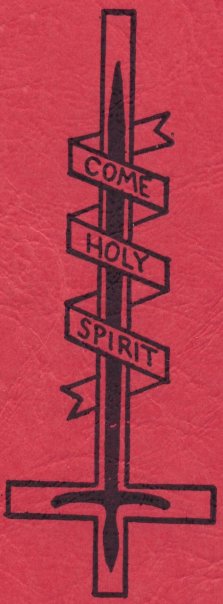
The symbols of Sts. Peter & Paul are the inverted cross and two-edge sword
No agreement could be reached on the naming of the parish patron. Consequently, Fr. George Schneider resolved upon a unique scheme to settle all disputes regarding the name. Six candles dedicated to six patrons were lighted. St. Peter and St. Paul seemed to vie for the honor as their candles lingered longest, flickering out together. This left them no choice but to dedicate the parish to the two contenders for the honor. The symbols of Sts. Peter and Paul are the inverted cross, representing St. Peter’s martyrdom, and the two-edge sword, representing St. Paul’s writings.
On May 3, 1863, Fr. George Schneider laid the cornerstone and dedicated the church to Sts. Peter & Paul. It was a day of jubilee and the parish thereafter continued to grow. The church reportedly cost $337 and was an imposing structure for its time. One feature was a large, circular, spoked window above the main entrance. The enlarged church was able to accommodate the growing parish which, by January 1, 1864, counted 59 families.

In 1864, Adam Handel taught school in the old log church. Although Fr. George Schneider was not a resident pastor, he attended Clear Creek at regular intervals. However, in 1864, shortly after the building of the new church, Fr. George Schneider was transferred and for a while the parish was visited irregularly by priests.
.png)
Fr. Peter Matthew Hiltermann, O.S.F., preached a mission at Clear Creek from October 16, 1864 to October 22, 1864. In 1865 and into 1866, Fr. John Junker attended to Clear Creek. On January 28, 1865, the debt of $88 on the church was paid in full.
In May 1866 and June 1866, Fr. Johan Fendrick attended to Mass and the sacraments at Clear Creek.
In October 1866, Fr. Cyprian Zwinge, O.S.F., conducted funeral Mass and burial services at Clear Creek for John Trierweiler and Margaret Vogel.
In 1867, Fr. George Temmen became the first resident pastor of Baden, Iowa and between February 1867 and May 1870, attended Clear Creek at regular intervals as a mission of Baden. John Gum taught school at Clear Creek in 1867.
When Fr. George Temmen left Baden in May 1870, Fr. Gerard Luehrsmann became the second resident pastor of Baden and attended Clear Creek from August 1870 to 1874. Fr. E. McLaughlin, who was assigned pastor in Sigourney, also served Sts. Peter & Paul Catholic Church at Clear Creek in 1873.
Fr. Thomas Frauenhofer became the third resident pastor of Baden in February 1874 and continued to offer Sunday Mass at Clear Creek during his pastorate there, which lasted until January 1876. In May 1874, there was a successful mission at Clear Creek by Fr. Cyprian Eisele.
.png)
In 1875, Fr. Thomas Frauenhofer commenced construction of the first school building at Clear Creek. However, while Fr. Thomas Frauenhofer had the credit of building the first school building, he would not see the school in operation. He was transferred at the beginning of 1876.
Fr. Peter Kern succeeded Fr. Thomas Frauenhofer in 1876 as the fourth resident pastor of Baden and organized the parochial school at Clear Creek. Pupils were limited to those who were preparing to make their First Holy Communion. Fr. Peter Kern employed John Barth as the first teacher at the new school, who taught during the fall 1876 and spring 1877 terms. Then Peter Arens came and taught from 1877 until 1882.
At one time, the Diocese of Dubuque comprised the entire state of Iowa as well as territory in Illinois and Wisconsin. Previous divisions had taken territory outside the state of Iowa to give to other newly created dioceses. In 1881, the Diocese of Dubuque comprised the entire state of Iowa. The Most Rev. John Hennessy, Bishop of Dubuque, became convinced that the Dubuque Diocese should be further divided, with the Dubuque Diocese covering the northern half of the state of Iowa, and the southern half covered by a new diocese. Hennessy felt that the See of this new diocese should be located at Des Moines, Iowa. However, the Vatican chose Davenport as the See city of this Diocese. On June 14, 1881, the southern half of the Dubuque Diocese was taken to form the Diocese of Davenport. Fr. John McMullen, a priest in the Archdiocese of Chicago, was chosen to be the first Bishop of Davenport. Bishop John McMullen was ordained and installed as Bishop of Davenport by Archbishop Patrick Augustine Feehan of Chicago, Bishop John Hennessy of Dubuque, and Bishop John Lancaster Spalding of Peoria.
In 1882, John Barth returned for a second period of teaching the parochial school at Clear Creek and taught until 1887.
On October 2, 1882, the Most Rev. John McMullen, first Bishop of Davenport, administered the Sacrament of Confirmation at Sts. Peter & Paul Catholic Church. Ninety-two parishioners were confirmed.
.png)
Fr. John Fedler succeeded Fr. Peter Kern in the fall of 1887 and had charge of both Clear Creek and Harper until 1893. He did much by his zealous labor and his influence with the Most Rev. Henry Cosgrove, the second Bishop of Davenport, to prepare the parish for a resident pastor.
Constantin Buch taught school during the fall 1888 and spring 1889 terms. Otto Rauch came in 1889 and taught school at Clear Creek until 1895.
Fr. Joseph Rangger was appointed pastor of Sts. Peter & Paul Catholic Church in April 1893. Fr. Joseph Rangger had first been appointed pastor of Sigourney with Clear Creek as an out mission. However, at his request, the appointment was changed, and he became the first resident pastor of Clear Creek.
.png)
A resident pastor required a place of residence. On April 24, 1893, a parish meeting was held, and the parish resolved to build a rectory, the actual cost of which was about $1,400. On February 24, 1894, Fr. Joseph Rangger moved into the new rectory. The following week, from February 25, 1894 to March 4, 1894, the Redemptorist priests Fr. John B. Neu and Fr. Francis Straubinger preached a most successful mission at Clear Creek.
On October 5, 1894, the Most Rev. Henry Cosgrove, second Bishop of Davenport, administered the Sacrament of Confirmation at Sts. Peter & Paul Catholic Church. Fifty-eight parishioners were confirmed.
The Franciscan Sisters of St. Francis from Wisconsin succeeded Otto Rauch in the fall of 1895 and conducted the school at Clear Creek until 1902.
On September 15, 1897, the Most Rev. Henry Cosgrove, second Bishop of Davenport, once again administered the Sacrament of Confirmation at Sts. Peter & Paul Catholic Church. Forty-nine parishioners were confirmed. He encouraged the parish to build a new church. On October 6, 1897, Fr. Joseph Rangger began to collect for the project.
The last week of October 1897, Fr. Joseph Rangger visited the Quad Cities to meet with the architect about plans to build a new church. At that time, Fr. Rangger had already received cash donations of $5,000 and donations of seven windows.
The new church at Clear Creek originates from architectural plans by Ferdinand S. Borgolte of Rock Island, Illinois. The contractor was Harry Schroeder of Washington, Iowa. Brickmakers were Fuller & Schumacher of Muscatine, Iowa. The contract price was $5,850; not including bricks, furnishings, frescoes or lumber. The total cost estimate was $10,000.

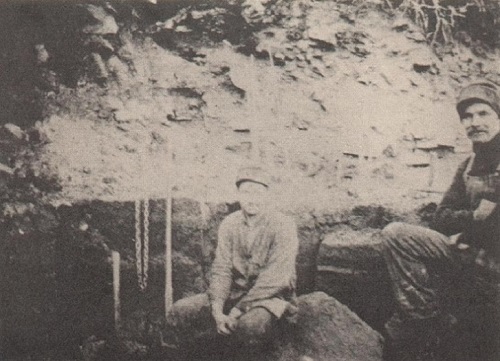
The old church, which stood by the new foundation, had witnessed the passage of a generation. The church where they had gone to worship and offer up a prayer and listen to the divine words of their pastor would soon be no more. The old church was to be torn down and, in its place, a new and grand edifice was to be erected. The members of the parish would see the rising up in its majestic proportions of a great temple to the living God. The old church would soon be gone, but not forgotten. The many baptisms, weddings, funerals, sacraments, and able sermons would be cherished in the memories of those who witnessed the ceremonies and heard the earnest words as they fell from the lips of their pastors.
The cornerstone for the new church was laid on Wednesday, June 8, 1898. It was witnessed by at least 1,500 people, and some estimated the audience at 2,000 people. The clergy in attendance were the Most Rev. Henry Cosgrove, Bishop of Davenport; assisted by Fr. Joseph Rangger, pastor; Fr. Peter Kern of Ft. Madison, Iowa; Fr. Fred Hoppman of St. Paul, Iowa; Fr. Schulte of Iowa City, Iowa; Fr. J.I. Grieser of Muscatine, Iowa; Fr. B. Jacobsmeyer of Washington, Iowa; Fr. James Cleary of Sigourney, Iowa; and Fr. Henry Grothe of Harper, Iowa. It was an impressive ceremony that was to be long remembered by those who were present.
At 9:00 a.m. on Wednesday, June 8, 1898, the clergy formed in line at the rectory and marched to the old church where High Mass was celebrated. The old church was decorated, and beautiful flowers were in profusion. Never did it look grander. At the conclusion of Mass, the clergy again formed in line and marched to the foundation where the new church would be built. The sermon was conducted by Bishop Cosgrove. After the sermon, Bishop Cosgrove proceeded to the spot where the altar would be in the new church and blessed the cross there erected.
When this was done, Bishop Cosgrove and the clergy marched around the foundation of the new church. Returning to the platform which adorned with beautiful decorations, the cornerstone of the new Sts. Peter & Paul Catholic Church was laid and blessed.
When this was completed, they returned to the platform and listened to a sermon delivered by Fr. Fred Hoppman. It was delivered in German and those understanding the language said it was a brilliant effort.
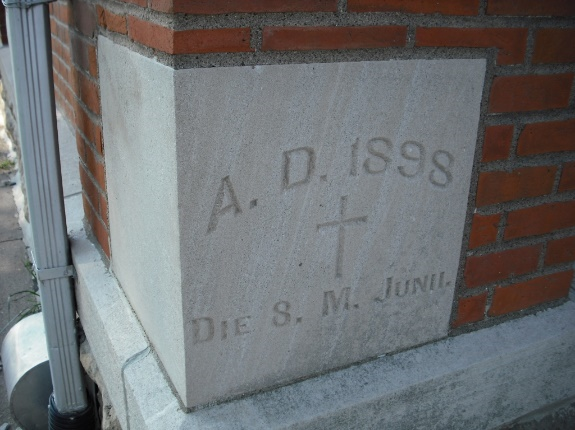
Immediately after Fr. Fred Hoppman’s address, Fr. Schulte addressed the congregation in English. He spoke feelingly and impressively. He had a wonderful voice and his oratory was grand. In part, he said, “the Catholic Church was progressing; that many souls had been conquered, not by arms, but by the cross; that many souls were brought into this world by God and saved by Christ.” He rejoiced that the members were going to have such a fine place of worship. He hoped that truth would be the watch word and nothing but truth would be spoken from the altar at Clear Creek; Christ had given the Church for the salvation of man. He said, “You have every reason, therefore, my brethren, to rejoice and be glad on this occasion, when you will see the beginning of what is to be a temple of God, your own church, where you will come to receive your God into your souls, to seek consolation in time of trial, to give thanks for past favors and blessings and to offer up to God the tribute of your homage and adoration in the greatest of all religious acts, the holy and adorable sacrifice of the Mass. You have abundant reason indeed to thank God for the gift of the true faith, whereby you can enjoy all these comforts and blessings. In this age of unbelief, when men are so indifferent to things spiritual and seem to forget all about God and the duties they owe Him of love, homage and adoration, it is a consolation to know that the faithful ones still remember Him and are ready to make sacrifices in order to have a proper place wherein to worship Him. The erection of a church is a sign that the faith of Christ still lives; it is an indication that the doctrines taught by the Apostles are still practiced. By the members of our own household of faith the building of this church is hailed with joy, as it marks the spread of our holy religion in this vicinity. To the people of every religious persuasion residing in this vicinity it ought to be also a pleasure to see rising up in their midst a noble edifice where saving truths of religion are to be taught, whose truths which alone can elevate the nature of man, make him a child of God, and in consequence, a faithful, up-right and law-abiding citizen of the State. One of our proudest boasts as a people is that we are always ready to respect and obey the laws of our land. But where is this very reverence for law more strongly inculcated than in the Catholic Church? Where are the duties of the citizens more strongly urged than within the walls of a Catholic Church? Our fundamental principle is that the better Christian a man is the better citizen he will make; that the faithful performance of our duty to God must necessarily make us good citizens.”
After Fr. Schulte’s address, Bishop Cosgrove stepped to the edge of the platform and desired in conclusion to say a word, which was in substance as follows: “It remains only for me as bishop to say a word of encouragement and exhortation that you may continue to correspond with the efforts of your pastor. To continue I say, you already have shown your zeal in the foundation of a new building which is nearing completion. It is not for himself, but for you and your children and your children’s children that this edifice is to be built. You must understand your responsibility and understand the sublime ends, for which this church is built and were so eloquently explained by the preacher. Remember all that God has done for you and with the gratitude of your hearts going out to Him, give back generously of the means He has given to you. Give generously and through the invocation of the Patron Saints of this church and you will be tenfold rewarded. They will look down upon this church and pray to God to those who promoted its erection. Let me exhort you to zeal in completing this temple. Let me call on Almighty God to bless this congregation, to bless you pastor, your families, that your children may grow up in chastity, in honesty, in loyalty to God, and in loyalty to country and in all that goes to make a true Christian and a devoted American citizen. It is not only the house of God but your house also; the house of prayer, of praise, of consolation in sorrow, of light in darkness, a little heaven on earth. Such will it be to you and yours for years to come.” At this time, Bishop Cosgrove gave his Episcopal blessing. At the conclusion, the clergy, choir, and vast audience united in singing “Holy God We Praise Thy Name.”
Foundation stone was quarried from a nearby field and the brick clay pit was located south of the building site. Machinery was shipped in for the making of the bricks and experts of Fuller & Schumacher were hired to conduct manufacturing operations of the 250,000 bricks. The number of bricks fell somewhat short of the needed amount, so new bricks had to be purchased which did not quite match the coloration of the first ones. Today, a close observer can detect the difference in texture and color of the bricks on the upper portion of the church and those on the lower layers.
Concerning the brick in the church, there is an interesting story told. Fr. Joseph Rangger was a man of strong mind. He was particularly concerned that the church should be built to endure, and he was not of a mind to tolerate shoddy workmanship. On one occasion, he complained to the contractor about a wall which was out of kilter and not to his satisfaction. Unable to obtain any remedy from the contractor, Fr. Joseph Rangger took care of the situation himself. He knocked down the wall and it had to be rebuilt.
The new church at Clear Creek is a fine example of vernacular architecture employing late Victorian Gothic stylistic details. The interior features three altarpieces of particular exuberance carved in Victorian Gothic style. Although they appear unsigned, they are attributed to Nickolas Juhl from Davenport, Iowa, and date circa 1899. Juhl was an accomplished wood carver, a native-born German, and a Jew. He carved altars for several Catholic churches in Davenport, Iowa. Attribution of the Clear Creek altars is made through Juhl’s association with the church’s architect, Ferdinand S. Borgolte of Rock Island, Illinois.
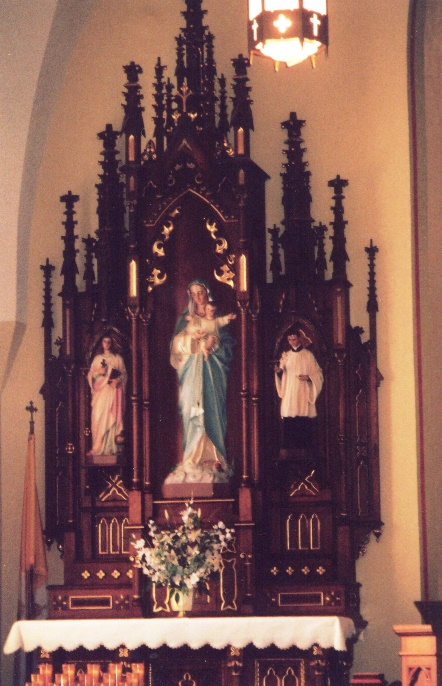

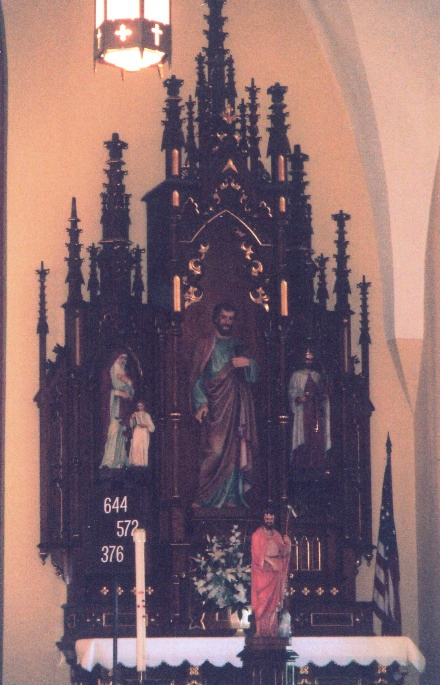
The altar is the focal point around which a church is built. The Hebrew word for altar means “place of sacrifice.” The Sacrifice of the Mass, which is the un-bloody reenactment of the Sacrifice of Calvary, is offered on the altar. Before the Second Vatican Council, the priest faced the altar and had his back toward the congregation. The central/main altar is also known as the high altar. On the left side when facing the high altar, St. Paul is holding the words of salvation. On the right side when facing the high altar, St. Peter is holding the Keys of the Church. In between the two Apostles is the Sacred Heart of Jesus Christ. On each of the far sides of the high altar is an angel to stand guard.
Faithful parishioners often turn to Mary and Joseph and ask them to intercede with God for help in obtaining spiritual and temporal needs for their families and others. As the mother of the Holy Family, Mary is a model for all mothers. The east altar features Mary holding baby Jesus and a rosary. The serpent is coiled at her feet with a red apple in its mouth. St. Joseph, as head of the Holy Family and foster father of Jesus Christ, is a model for all fathers. The west altar features St. Joseph holding the carpenter tool. Before the Second Vatican Council, these side altars were sometimes used for the Holy Sacrifice of the Mass if two priests offered Mass at the same time. In later years, if more than one priest wished to offer Mass at the same time, all those wishing to participate concelebrated. The devotions of the faithful prompted them to decorate these shrines with flowers and candles.
An altar stone is a solid piece of natural stone containing relics. It is consecrated by a bishop and large enough to hold the Sacred Host and chalice. The altar stone is inserted into or placed on the surface of an altar. Clear Creek had three altar stones corresponding to the three altars. The altar stones from Mary’s altar and Joseph’s altar are small and made of smooth marble; they contain no engraving and we know nothing about their history. The altar stone from the high altar is the largest and the only stone with engraving, the only stone we know anything about.
The slate slab that makes up the altar stone in the central altar is engraved in Latin and dated 1854. The four crosses in each of the corners of the stone represent God in all corners of the word; the cross in the center represents Christ who is the Center of All. The name in Latin (Paulus Georgius Maria DuPont des Loges, Episcopus Metensis) was believed by Fr. Timothy Regan, pastor from 1994 to 2001, to be the name of the French bishop who consecrated the stone. Early settlers may have brought it with them from Germany to establish their church here and moved it over from their previous church.
The nave and sanctuary have 14 windows. They feature brick, Gothic arches, cast stone sills and fixed sash with stained glass. Each window bears a beautiful painting, representing different saints. The paintings were very expensive, costing $50 each at that time, and were donated respectively by the following people/families/groups: St. Joseph, donated by Fr. Joseph Rangger; St. James, donated by my great-great-grandfather Jacob Conrad; St. Mary Magdalene, donated in memory of Paul Peiffer; St. Matthias, donated by Matthias Bohrofen; St. Nicholas, donated by Nicholas Berg; St. Ann, donated by Magdelena Klein; St. Rose of Lima, donated by the Jungfrauen Vereen (German for Young Ladies’ Sodality); St. Barbara, donated by Nicholas Peiffer; St. Catherine, donated by the Weber Family; St. Michael, donated by Michael Peiffer; St. Liborious, donated by Liborious Conrad; St. Margaret, donated in Memory of my great great-grandfather Peter Greiner; St. Francis of Assisi, donated by Frank Lutz; St. Lawrence, donated by Fr. Lorenz Conrad, brother of Jacob Conrad.
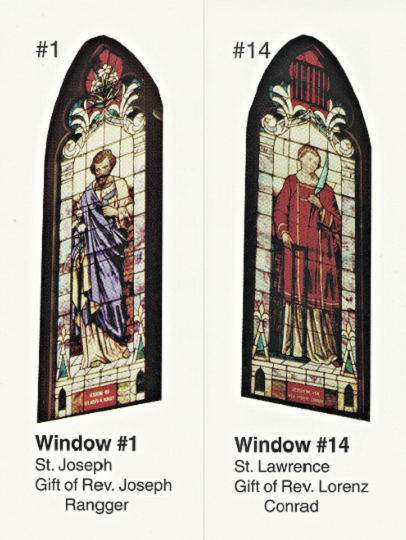
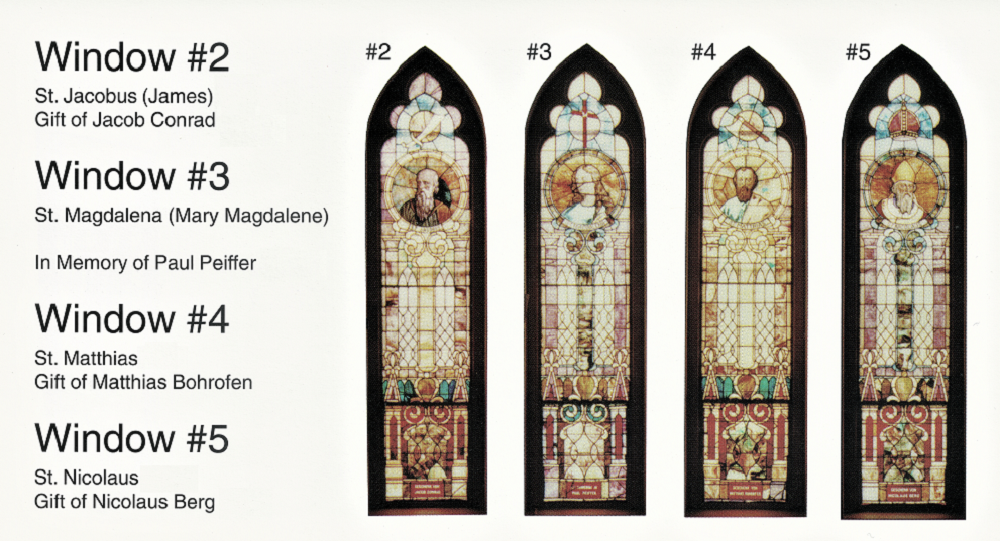
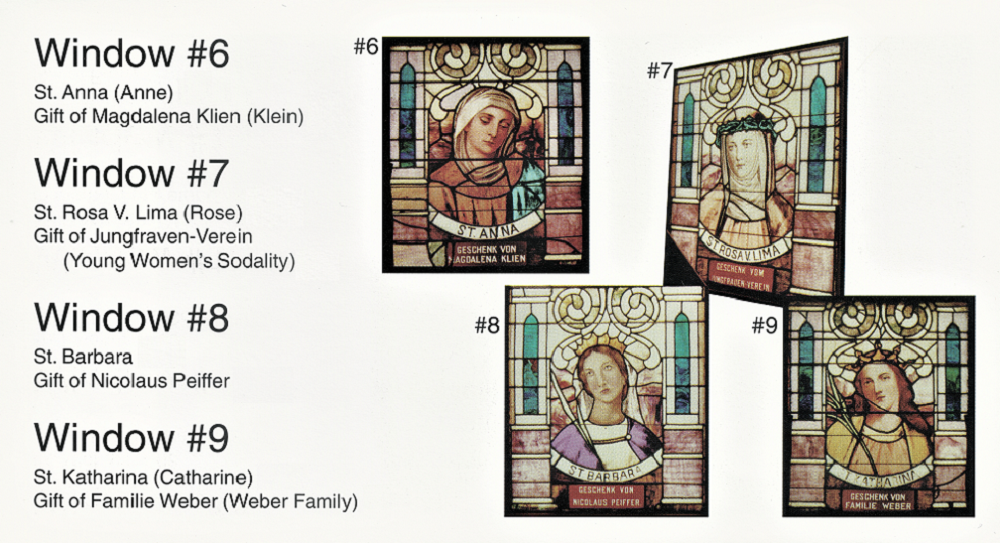
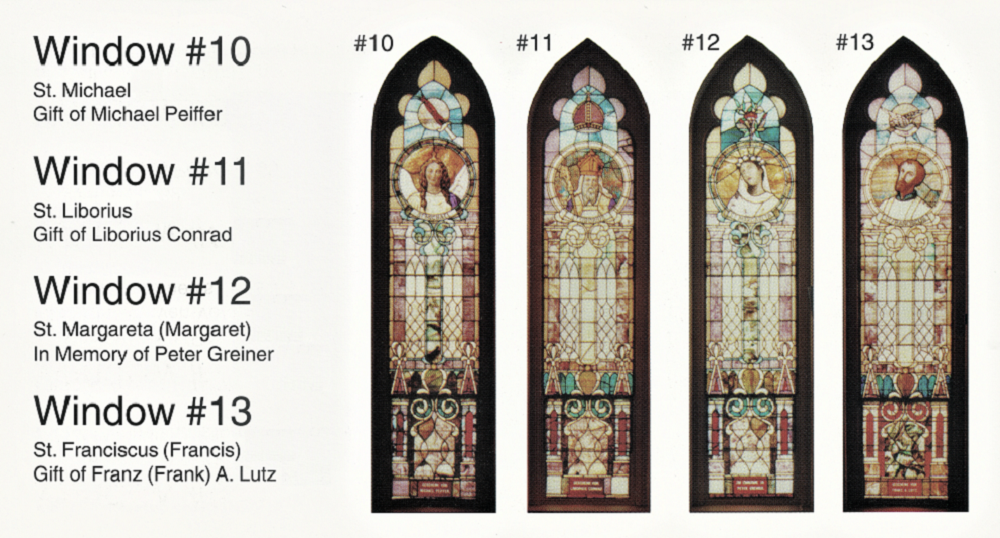

Once the church was completed, Fr. Joseph Rangger found that only a few hundred dollars were necessary to pay all the bills for the construction of the new church. Wishing to have a debt-free church for the dedication, he called the people to Mass in the newly finished church on Sunday, April 16, 1899, two days before the dedication. Once the congregation was inside and admiring the magnificence of the new building, he locked the doors. Until the parishioners shelled out enough money to make up the deficit, he would not open them. On Tuesday, the building was dedicated debt-free.
Tuesday morning, April 18, 1899, was the day set for the dedication of the new church. It was well-decorated for the occasion. At 9:30 a.m. the solemn and impressive ceremonies commenced. The clergy in attendance included the Most Rev. Henry Cosgrove, Bishop of Davenport; assisted by Fr. Joseph Rangger, pastor; Fr. Jacobsmeyer of Washington, Iowa; Fr. Hauser of Sigourney, Iowa; Fr. Henry Grothe of Harper, Iowa; Fr. Fred Hoppman of St. Paul, Iowa; Fr. George Herr of Dyersville, Iowa; and Fr. Peter Kern and Fr. Zaiser of Ft. Madison, Iowa. Twelve bright altar boys were engaged for the services, and they did their part well, making not a single error to mar the occasion.
After the Gospel, Fr. Peter Kern delivered an eloquent sermon in the German language, from the eighty-third Psalm, first verse. Fr. Peter Kern is an able speaker. His address was impressively and feelingly delivered. He was listened to by apt attention. He first congratulated the congregation on this magnificent structure, erected by their zeal and generosity. The speaker then passed over to the consideration of the dignity and sanctity of the church, showing by apt comparisons and strong arguments the dignity and sanctity of the house of God. He argued that if the temple of the old law was dignified and holy, much more is the church of the new law dignified and holy, because it is not only a house of prayer, but also a house of sacrifice wherein is offered up the oblation of the new law. In conclusion, Fr. Peter Kern encouraged the members to continue their good work, and to remain firm in the faith. Fr. Peter Kern was followed by Fr. Zaiser, who delivered an eloquent eulogy upon the magnificent church, and congratulated parishioners on their noble work, as it was God’s work.
At the conclusion of the morning services, Bishop Cosgrove stepped to the front of the altar and spoke impressively. He remarked that he had just listened to two able and appropriate discourses, and he could not let this solemn occasion go by without encouragement and praise. He wanted to congratulate the people on this magnificent structure, when he took in consideration the few short months previous when he had come and laid the cornerstone. He announced, “Surely faith and piety did much in so short a time. This temple erected to Almighty God by you and your pastor is deserving of praise. Remember that it was not built for man, but for God.” Bishop Cosgrove related a beautiful story of Jacob, wherein he said in part, “God is here. This church is certainly a legacy to your children. When you are laid away in your final resting place you need have no other stone to mark your grave, but you will have this church which the Almighty God has given you, as a monument to your efforts and zeal.” In conclusion, Bishop Cosgrove wished the congregation every prosperity and eternal happiness to come. The congregation and choir then sang, “Holy God We Praise Thy Name.”
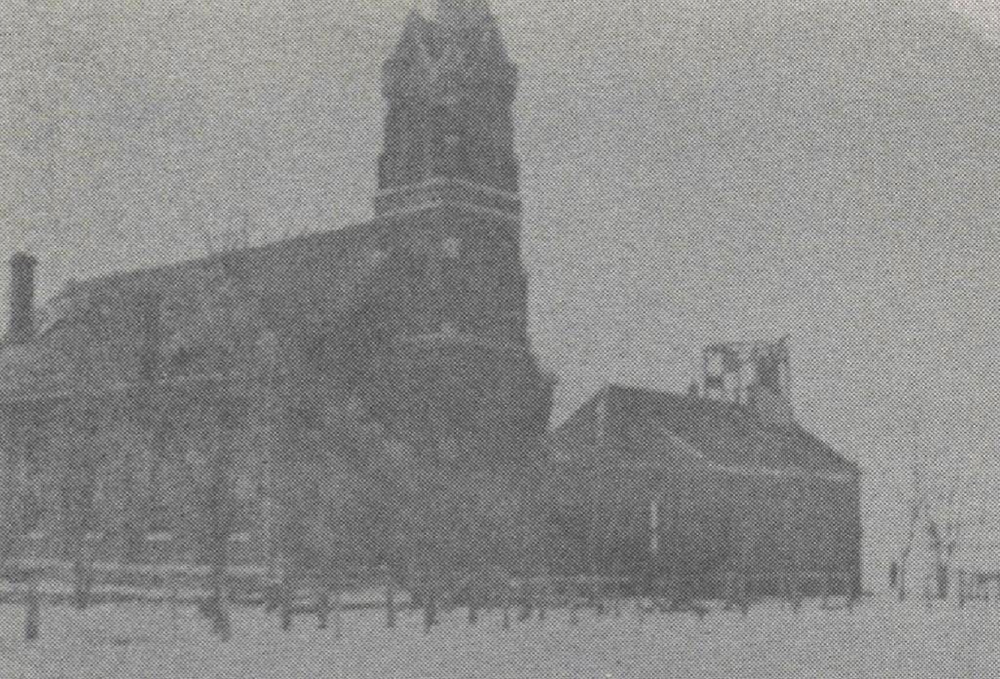
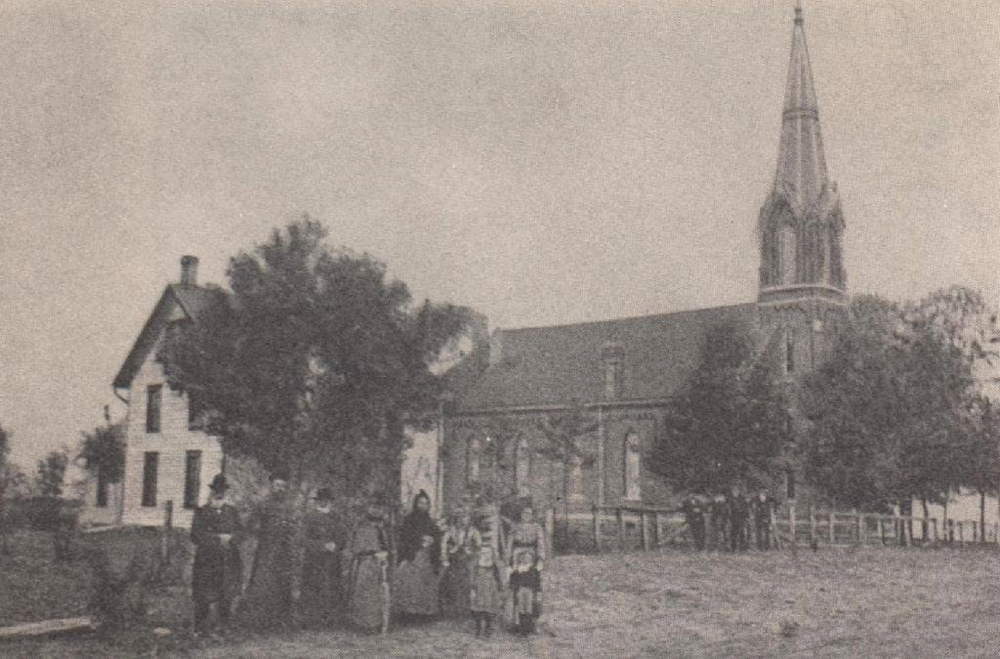
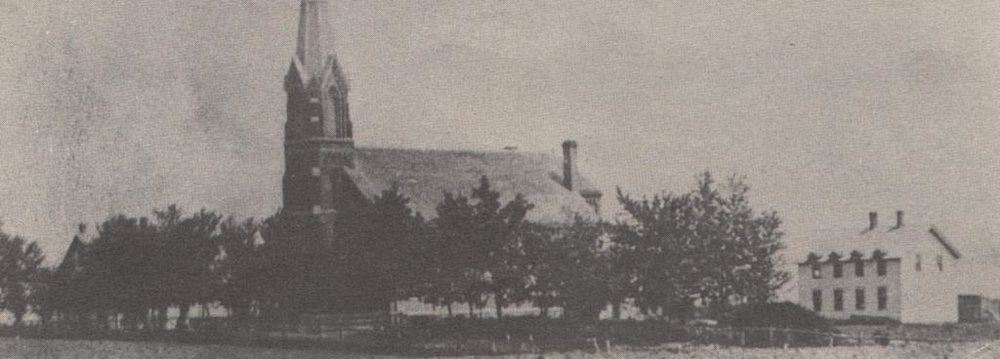
On June 5, 1899, Fr. Joseph Rangger left to spend the summer in Germany. The Most. Rev. Henry Cosgrove, Bishop of Davenport, appointed the newly ordained Fr. Frank Kottensttette to be pastor at Sts. Peter & Paul Catholic Church at Clear Creek in the absence of Fr. Rangger.
On October 17, 1900, the Most Rev. Henry Cosgrove, Bishop of Davenport, again visited Sts. Peter & Paul Catholic Church at Clear Creek to celebrate the Sacrament of Confirmation. Forty-three parishioners were confirmed.
For the fall of 1902, Fr. Joseph Rangger obtained the services of the Sisters of the Most Precious Blood to teach the school at Clear Creek, although they remained only a few months. Fr. Joseph Rangger departed on November 14, 1902.
.png)
Fr. Henry Grothe, who was already pastor of St. Elizabeth Catholic Church in Harper, attended to Clear Creek between November 1902 and August 1903. He employed Miss Veronica Rung to finish teaching the fall 1902 and spring 1903 school terms.
Fr. Peter Stahl was appointed the second resident pastor of Clear Creek in August 1903. He obtained the services of the School Sisters of St. Francis from Milwaukee, Wisconsin to teach the school at Clear Creek.
On April 7, 1905, the Most Rev. Henry Cosgrove, Bishop of Davenport, again visited Sts. Peter & Paul Catholic Church at Clear Creek to celebrate the Sacrament of Confirmation. Forty-seven parishioners were confirmed.
.png)
On June 15, 1905, the first Holy Mass of Fr. N. J. Peiffer was celebrated at Sts. Peter & Paul Catholic Church at Clear Creek. It was a solemn High Mass. with Fr. Peiffer celebrant, Fr. J. I. Grieser as assistant priest, Rev. J. Adam as deacon, Rev. P. Kettler as sub-deacon, and Rev E. Weil as master of ceremonies. Fr. Peter Kern of Fort Madison preached an eloquent and impressive sermon, explaining the duties of the priest to the people and the obligations of tho people to the priest in a thorough and convincing manner. Tho church was beautifully decorated in honor of the occasion of the first Holy Mass of one of the members of the parish raised to the sublime dignity of the priesthood. The good Sisters had carefully trained the children for the procession and had the altars decorated very handsomely. The music of the Mass was beautiful as well. The most joyful of the large congregation present were the happy parents of tho celebrant, Mr. N. Peiffor and Mrs. Anna Margaretha (Buch) Peiffer. Tho weather was auspicious, enabling all to attend the ceremony. The clergymen present at the Mass were Fr. Peter Stahl, pastor of St. Peter & Paul Catholic Church at Clear Creek, as well as Fr. Peter Kern from Fort Madison, Fr. Henry Grothe from Harper, Fr. Bernard Jacobsmeier from Riverside, Fr. Ed Well from Richmond, Fr. Frank Kottenstette from Hills, Fr. J. Fadlar from Panama, Fr. J. Hauser from Sigourney, and three sub-deacons from St. Paul. Fr. Peiffer studied at St. Francis, Wisconsin, and the last year and one-half at St. Paul, Minnesota, where he was ordained.
In November 1905, Fr. Peter Stahl was admitted to Mercy Hospital in Davenport, Iowa, where he underwent an operation for appendicitis. He returned to Clear Creek on Wednesday, November 15, 1905.
During his pastorate, Fr. Peter Stahl began construction of a new school at Clear Creek. The cornerstone was laid on June 19, 1906. It was dedicated on October 2, 1906. The building plans for the new school incorporated larger and more convenient living quarters for the teaching nuns. Another interesting feature of the new school was an arrangement for boarding students. Some students still walked five and ten miles to school, but many families boarded their children. They would leave the children after Mass on Sunday and pick them up again on Friday after school. The nuns served not only as teachers but day and night care providers in every sense of the word. Records show that lots of fried potatoes were prepared by these surrogate-mother nuns for their charges at mealtime. Many times, they were hard-pressed for sleeping accommodations for these youthful boarders. The children would often sleep three to a bed.
.png)
Fr. Henry Sendbuehler came in September 1907 to succeed Fr. Peter Stahl. One of his first tasks was paying the remaining debt on the new school. Fr. Henry Sendbuehler would remain pastor at Clear Creek until 1923.
In 1911, in preparation for the Golden Jubilee, the statues of St. Henry, St. Aloysius, St. Ann, and St. Mary Magdalene were purchased and added to the side altars in the church.
Two of the three bells in the steeple were also purchased for the Golden Jubilee. The Stuckstede Company of St. Louis, Missouri, which provided bells for many other churches in the diocese, cast the bells. The larger of the two bells, donated by Nick Weber in memory of his wife, weighs 2,060 pounds and cost $566.09. The smaller bell, donated by the children of Frank Schmitt, weighs 1,100 pounds and cost $290. On the feast of the Ascension in 1911, after a sermon by Fr. J.G. Hauser, pastor in Sigourney, the bells were blessed by Fr. W.P. Hoppman.
Prior to 1911, Sts. Peter & Paul Catholic Cemetery at Clear Creek ended at the west end of the original section of the cemetery. In 1911, the cemetery was to be enlarged and laid out in plots. Joseph and Helena Sieren owned land bordering the east, south, and west sides of the church and cemetery property. On June 27, 1911, the parish gave Joseph and Helena Sieren 10 acres of land along the south side of the parish’s property and in return Joseph and Helena Sieren gave the parish 10 acres of their land along the west side of the parish’s property with which the parish could use to expand the cemetery to the west. As the new cemetery addition was being laid out, a road was built between the original section and the new addition. The desired location of the road was to cross the plots where some members of the parish had been laid to rest and some plots had to be moved.
On June 27, 1911, the Most Rev. James Davis, Bishop of Davenport, visited Sts. Peter & Paul Catholic Church at Clear Creek to celebrate the Sacrament of Confirmation and the parish's Golden Jubilee. This is not a significant date except that it had been 50 years since Fr. George Schneider came on a scheduled basis to offer Mass. Nearly two thousand people and a large number of priests were gathered together to celebrate tho 50th anniversary of tho founding of the parish and to witness the Confirmation of a large class of 56 young people. The celebration began with a solemn Pontifical Mass at 8:00 a.m., with the Most Rev. James Davis, Bishop of Davenport, as the celebrant. Others in attendance were Msgr. Linnenkamp from St. Joseph, Missouri; Fr. F. Hoppmann, V.F. from Ottumwa, Iowa, who served as the deacon of honor; Fr. J. Grieser from Muscatine, Iowa, who served as the assistant priest; Fr. Peter Kern from Ft. Madison, Iowa; Fr. Henry Grothe from Harper, Iowa; Fr. Bernard Jacobsmeier from Riverside, Iowa; Fr. Frank Kottenstette from Hills, Iowa, who served as the sub-deacon of honor; Fr. Hauber from Davenport, Iowa, who served as master of ceremony; Fr. J.G. Hauser from Sigourney, Iowa; Fr. N. Peiffer from Buffalo, Iowa, who served as the deacon of Mass; Fr. Peter Stahl from Richmond, Iowa, who served as master of ceremony; Fr. J.P. Stahl from Davenport, Iowa; Fr. F. Nugent from Kinross, Iowa; and Fr. John Scherf from Davenport, Iowa; and Michael Schmitt was the sub-deacon of Mass. The church was unable to hold the immense number of people that had gathered and many stood outside of the doors.
After Mass, Fr. Peter Kern delivered the German sermon. Fr. Peter Kern had been pastor of Clear Creek some twenty-five years earlier, and he spoke with deep-feeling, calling attention to the changes wrought by Father Time since his day. He said that he still recognized some of the faces before him, but in the main it was a new generation. He congratulated the parish on its growth in numbers and especially in fidelity and service to Mother Church. "This is a great day of rejoicing," Fr. Peter Kern said. "There is joy in Heaven at this manifestation of persevering fidelity to God's work, joy in the universal Church which sees one of its branches prospering, joy in this parish and rightly so, for you may justly be proud of your work." Fr. Henry Grothe then spoke In English. He was also a former pastor and well acquainted with the history of the parish, and the sincere congratulations that he offered came from his heart. Especially did he compliment the people on their splendid work in maintaining through all these years a parochial school, under difficulties that would have long ago discouraged the average Catholic congregation. His sermon was followed by the Confirmation exercises.
The Most Rev. James Davis, Bishop of Davenport, addressed the people, congratulating them and asking them to continue their great work. "Sts. Peter & Paul's congregation," he said, "is noted beyond others for its faithful and zealous people, and what is it that makes a congregation great in the sight of God? Is it a large church, or the numbers who attend there? No, it is the number of those who are kept in faith and in the grace of God by the parish ministries. Continue your good work for another fifty years and if at the end of that time these young people who are now being confirmed can assemble in this church, the old people of the parish, and look back with as much satisfaction on the past as you are rightly doing now, your parish will indeed be great in the sight of God." Confirmation was followed by Benediction of the Most Blessed Sacrament and the solemn singing of the "Te Deum."
A monstrous tent was spread, easily accommodating a thousand poople, and here a banquet was prepared for all. There were also other amusements and attractions, and with the ideal weather conditions, the day was to be remembered as a happy and glorious one in the history of the parish.
The next day, on Wednesday morning, June 28, 1911, there was a Solemn Requiem Mass for the deceased of the parish, followed by the solemn blessing of a magnificent new crucifixion group erected in the cemetery.
While Fr. Henry Sendbuehler took a well-earned vacation to Europe to visit the old home and his parents during the summer of 1911, the parish sold the first rectory and began construction of a new rectory. Before his departure, Fr. Henry Sendbuehler had initiated the undertaking by completing the sale of the old rectory and providing plans for the new rectory, but the building was done during his absence. Records state that the old rectory was purchased by Peter Adrian, Sr. and it was moved to the Adrian farm east of the church property.
On August 12, 1911, Pope Pius X split off the western half of the Diocese of Davenport to form the Diocese of Des Moines. Bishop Austin Dowling from Providence, Rhode Island was appointed the first bishop of Des Moines.
On July 25, 1912, Michael Schmitt, a native of Clear Creek and graduate of St. Ambrose College, was ordained a deacon and the following day, July 26, 1912, he was ordained a priest by Bishop Wehrle of Bismarck, South Dakota. Both ceremonies were held at Sts. Peter & Paul Catholic Church at Clear Creek. Fr. Schmitt celebrated his first Mass at Clear Creek on Tuesday, July 30, 1912. He was assigned to a parish in the Bismarck diocese.
A parish mission conducted by Fr. F. Schroeder, a Dominican priest from Minneapolis, Minnesota, was held between October 19, 1913 and October 26, 1913. In the choir loft, there was a mission cross dated October 1913. When a parish had a mission, they purchased a cross. This cross probably served as a primary focus throughout the mission. The mission cross was repainted and hung on the tower wall in the choir loft in preparation for the parish centennial in 1958. It served as a reminder of the mission and the spiritual lessons learned.
On November 5, 1914, the Most Rev. James Davis, Bishop of Davenport, visited Sts. Peter & Paul Catholic Church at Clear Creek to celebrate the Sacrament of Confirmation.
Modernization of the facilities at Sts. Peter & Paul Catholic Church gradually took place during the second decade of the twentieth century. In 1915, the storm windows were installed on the church by DePrato Statuary Company of Chicago, Illinois. The Young Men’s Sodality and the Young Ladies Sodality each paid for one window while voluntary donations paid for the rest.
In 1916, Campbell furnaces were installed in the church and a bathroom was installed in the Sisters’ dwelling. The school children continued to use the outdoor plumbing facilities until 1955 when indoor restrooms were built.
In 1916, parishioners were extremely proud of the frescoes which were put on the ceiling of Sts. Peter & Paul Catholic Church. The work was done by an Italian artist named Faliero Conquidi of the John Amidei Company in Chicago, Illinois. An artist named D. Beanci from Davenport, Iowa, executed two large pictures; one of St. Francis of Assisi, paid for by the St. Aloysius Sodality, and another of St. Rita, paid for by the St. Agnes Sodality.
On June 26, 1917, the Most Rev. James Davis, Bishop of Davenport, visited Sts. Peter & Paul Catholic Church at Clear Creek to celebrate the Sacrament of Confirmation.
In 1919, parishioners of Sts. Peter & Paul Catholic Church purchased a tabernacle and some vestments, gold-plated the chalice and ciboria, and erected an iron fence on two sides of the cemetery as well as in front of the church. This was in gratitude for the safe return of the 18 young men who served in the United States military during World War I and for protection against the Spanish influenza, which had plagued so many throughout the United States at that time.
On April 19, 1921, the Most Rev. James Davis, Bishop of Davenport, visited Sts. Peter & Paul Catholic Church at Clear Creek to celebrate the Sacrament of Confirmation.
In 1921, Fr. Henry Sendbuehler traveled to Europe, during which he visited Rome and enjoyed an audience with Pope Benedict XV. He also spent some time at his childhood home in Germany where his brothers and sisters still reside. He visited many places of religious and historical interst. He returned home in October 1921 to a warm welcome from the people of Clear Creek.
In 1922, a new roof was needed on Sts. Peter & Paul Catholic Church. C.P. Hammes was contracted to lay asbestos shingles for $1,500. The parish oversubscribed $300 in a collection to pay for the new roof.
In late July 1923, Fr. Henry Sendbuehler was immediately transferred from Sts. Peter & Paul Catholic Church at Clear Creek to St. Elizabeth Catholic Church in Harper. The Most Rev. James Davis, Bishop of Davenport, appointed Fr. Philip Hartman to succeed him temporarily as pastor of Clear Creek.
.png)
In September 1923, Fr. Bernard Luedtke became pastor of Clear Creek. Fr. Bernard Luedtke was plagued with poor health during this pastorate. Nevertheless, he initiated the installation of a light plant and the electrical wiring of the buildings. He also devoted much energy to beautifying the cemetery.
On May 8, 1924, the Most Rev. Edward Howard, Auxiliary Bishop of Davenport, visited Sts. Peter & Paul Catholic Church at Clear Creek to celebrate the Sacrament of Confirmation.
Fr. Bernard Luedtke died on September 20, 1927. Fr. John Scherf came to Clear Creek in October 1927 and remained until July 1, 1928. Fr. John Scherf completed the installation of a light plant and the electrical wiring of the buildings.
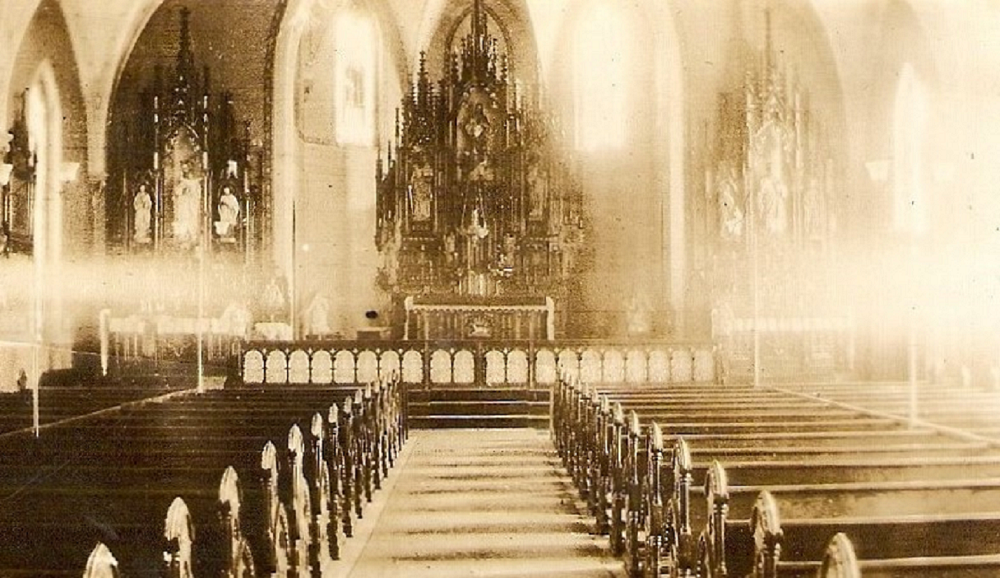
Fr. Hugh King, C.P. conducted a mission at Sts. Peter & Paul Catholic Church at Clear Creek from May 13, 1928 through May 20, 1928.
On May 17, 1928, the Most Rev. Henry Rohlman, Bishop of Davenport, visited Sts. Peter & Paul Catholic Church at Clear Creek to celebrate the Sacrament of Confirmation.
.png)
Fr. William Schmidt came to Clear Creek on July 1, 1928 and remained until July 1, 1930.
In June 1929, the statue of the Sacred Heart of Jesus was dedicated at Sts. Peter & Paul Catholic Church at Clear Creek. This statue is seen in altar photos of the time, although no one knows what happened to the statue.
On Saturday morning, June 29, 1929, Sts. Peter & Paul Catholic Church at Clear Creek observed the Solemnity of Saints Peter & Paul with solemn High Mass at 9:00 a.m. Those in attendance were Fr. O.J, McGuire from Washington, Iowa, who served as the celebrant; Fr. Francis Schaefers from Harper, Iowa, who served as the deacon; Fr. Thomas J. Wolfe from Kinross, Iowa, who served as the sub-deacon; and the pastor, Fr. William Schmidt, who served as the master of ceremonies. A most interesting sermon was preached by a former pastor, Fr. Joseph Rangger, who at this time was assigned to St. Paul, Iowa. He extolled the lives St. Peter and St. Paul as well as some of the other apostles. But mostly talked of St Peter, whom Christ made the head of His Church, to build His Church upon him and to give him the keys of the Kingdom of Heaven. The altars were artistically decorated with spring flowers, the work of the members of the Young Ladles sodality. After the Mass, solemn Benediction of the Blessed Sacrament was given. There was a large congregation present that taxed the capacity of the church.
On Tuesday, October 8, 1929, at 9:00 a.m., the beautiful devotion of the Forty Hours' adoration was opened at Sts. Peter & Paul Catholic Church at Clear Creek. Solemn High Mass of Exposition was celebrated by a former pastor, Fr. Henry Sendbuehler from East Pleasant Plain, Iowa, assisted by Fr. Francis Schaefers from Harper, Iowa, who served as deacon; Fr. Thomas J. Wolfe from Kinross, Iowa, who served as sub-deacon; and the pastor, Fr. William Schmidt, who served as master of ceremonies. Following the solemn procession of the men of the parish and the clergy carrying the Blessed Sacrament, the Litany of the Saints was chanted. A certain number of families were appointed by the pastor for adoration and these with other visitors kept up a continual adoration during each hour of the three days. This opportunity afforded by Father William Schmidt, enabled the parishioners to gain all the rich Indulgences granted hy the Holy Father during the Jubilee year. The pastor and parishioners were deeply grateful to Fr. Charles Dohmen from Clinton, Iowa for the inspiring and instructive sermons delivered during the three days. Fr. O.J. McGuire from Washington, Iowa, who was to asslst in the ceremonies on Thursday, was unable to make the trip because of the heavy rainfall. The closing of the Forty Hours' took place on Thursday nfternoon, October 10, 1929, on account of the unfavorable weather. At 3:00 p.m., Solemn Benediction of the Blessed Sacrament was given by Fr. Bernard J. Decker from Keota, assisted bv Fr. Charles Dohmen and Fr. William Schmidt. The solemn procession again took place and the closing sermon wns preached by Fr. Charles Dohmen.
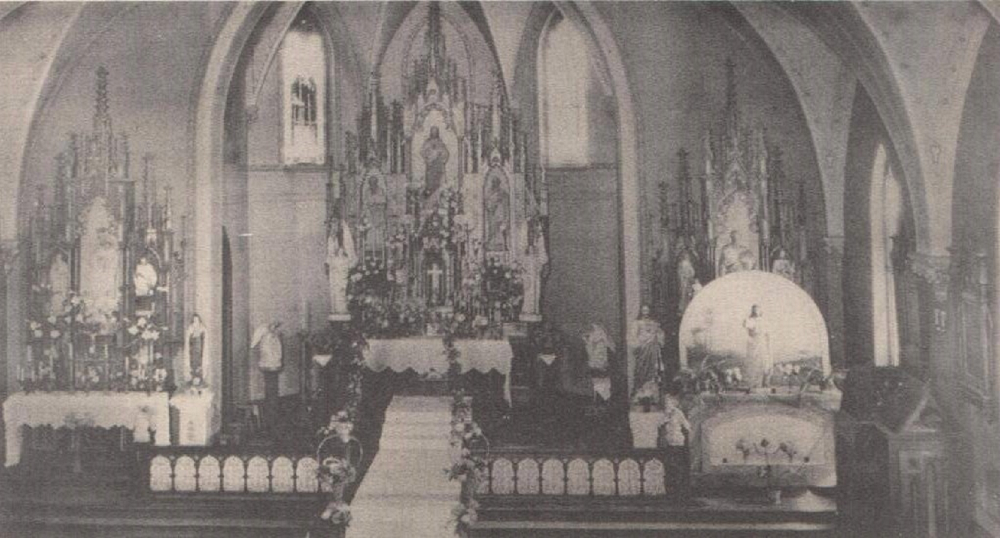
On May 25, 1930, school graduation exercises were held at Sts. Peter & Paul Catholic Church at Clear Creek. To the strains of the march the graduates escorted by two little white-clad girls and boys slowly made their way through the center aisle of the church. The instructive commencement address was delivered by Fr. Francis Schaefers from Harper. The diplomas were distributed by their pastor, Fr. William Schmidt. Each graduate was escorted through the white carpeted aisle and the beautiful arch of roses to the sanctuary by the little flower girls and boys. After the graduation exercises, solemn Benediction was given. The graduates were very happy to have their former pastor, Fr. Henry Sendbuehler, in attendance.
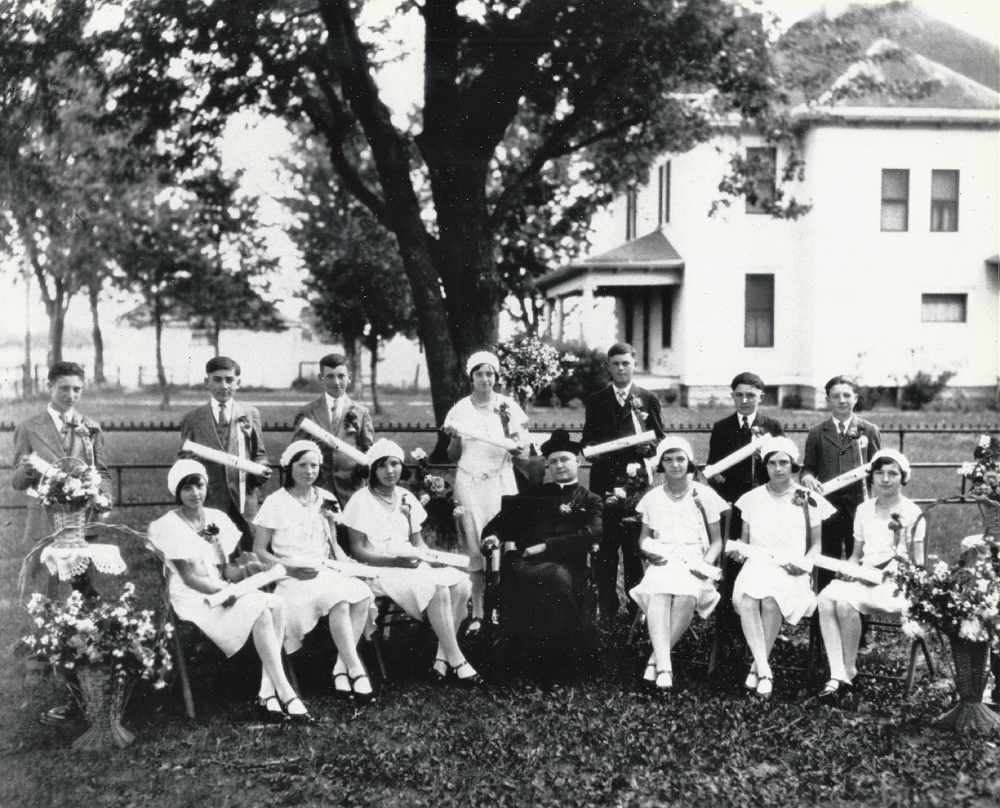
A strange thing happened on July 1, 1930, when Fr. William Schmidt left as pastor of Sts. Peter & Paul Catholic Church to be succeeded by Fr. Paul Kleinfelder. Before leaving that morning, Fr. William Schmidt had cleaned out the last of the debris and burned some papers in the furnace so as to leave everything orderly for his successor. Somehow, no one knows just how, whether it was sparks from the chimney or what, the dry shingled roof caught fire.
Farmers in their fields first noticed the smoke curling from the rectory roof. They came running but arrived too late to save the rectory. What they could do, they did. Swarming into the rectory, they tried to save the furnishings and anything movable. Out the windows came bedclothes and linens, doors were taken off their hinges, and furniture was carted out and placed in the lawn.
.png)
When Fr. Paul Kleinfelder and his housekeeper Grace Heller arrived later in the day, they found a heap of ashes where they expected to find a commodious rectory. Fr. Bernard J. Decker from Keota also tendered the hospitality of his home to Fr. Paul Kleinfelder pending arrangement for his temporary quarters. Since school was not in session, Fr. Paul Kleinfelder and Grace Heller moved into the living quarters of the school until the new rectory was completed that fall.
Fr. Paul Kleinfelder immediately began to plan and collect for the erection of a new rectory. A building committee of Fr. Paul Kleinfelder, C.P. Hammes, Mike Hammes, Felix Weber, and Frank Peiffer was elected and instructed to build a new rectory.
The situation was difficult. Already the parish had a debt of $2,500. Now an additional $3,500 was needed to pay for the new rectory. The money was borrowed, not to be repaid until August 1, 1942, when the mortgage was burned at a gala parish celebration. During those intervening years, many other necessary improvements forestalled the payment of the debt, try as the parish did to reduce it.
During the Great Depression, the parish bazaar at Sts. Peter & Paul Catholic Church at Clear Creek was a necessary fundraiser. The first bazaar was held in 1931. The parish treasury contained no money. Sister Sigismunda got St. Anthony’s statue down from the shelf, lit a vigil light, baked a fruit cake, and announced that the cake would be raffled off at $5.00 a chance. Some $19.00 came in on that one fruit cake and the bazaar was born.
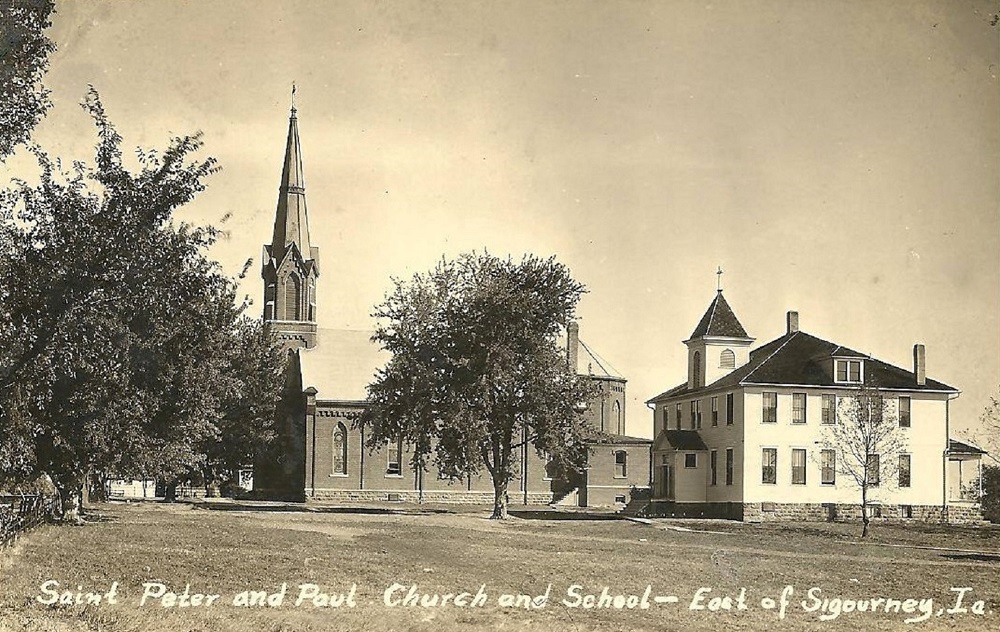
On September 24, 1931, the Most Rev. Henry Rohlman, Bishop of Davenport, visited Sts. Peter & Paul Catholic Church at Clear Creek to celebrate the Sacrament of Confirmation.
On September 9, 1932, Fr. Lionel E. Pire, a mission priest of the Congregation of the Precious Blood, opened a mission at Sts. Peter & Paul Catholic Church at Clear Creek. The mission continued through September 25, 1932.
Between 1933 and 1934, a basement was excavated below Sts. Peter & Paul Catholic Church at Clear Creek and made into a parish hall. At this time, the only outside entrance to the basement was on the south side.
On October 10, 1934, the Most Rev. Henry Rohlman, Bishop of Davenport, visited Sts. Peter & Paul Catholic Church at Clear Creek to celebrate the Sacrament of Confirmation.
On Monday, September 2, 1935, Sts. Peter & Paul Catholic Church at Clear Creek celebrated the parish’s Diamond Jubilee. The Most Rev. Henry Rohlman, Bishop of Davenport, celebrated a Solemn Pontifical Mass at 10:00 a.m. The deacons of honor were Fr. N.J. Peiffer from Muscatine, Iowa; Fr. Henry Sendbuehler from St. Paul, Iowa; and Fr. John Adam of Houghton, Iowa. Other assistants included Fr. Michael Schmitt of Dickinson, North Dakota, who served as deacon of the Mass; Fr. Francis Schaefers from Harper, Iowa, who served as the sub-deacon; and Fr. Edward Collins from Sacred Heart Cathedral in Davenport, Iowa, who served as the master of ceremonies. Other clergy in attendance were Msgr. Bernard Meyer, Apostolic Prefect from China; Fr. John Manning from Kinross, Iowa; Fr. E.C. Keating and Fr. Thomas J. Wolfe from Centerville, Iowa; Fr. Bernard J. Decker from Ottumwa, Iowa; and Fr. James Quinlan from What Cheer and Keswick, Iowa. The church was beautifully decorated with flowers, wreaths, streamers, and flags. Appropriate numbers were beautifully sung by the choir, with Sister M. Lipharda, Order of St. Francis, at the organ.
The sermon was delivered by Fr. N.J. Peiffer from Muscatine, Iowa, who spent his boyhood days in the Clear Creek community, was from the text of Exodus 3:5: "Come not nigh hither, put off the shoes from thy feet: for the place whereon thou standest is holy ground." He dwelt upon the long history of the Clear Creek community, centered around its church and school, and the great part this center has played in the life of the community. Fr. N.J. Peiffer said, "For seventy-five years this place has been the center of devotion in this community. For that span of years spiritual vitality, moral strength, and power as from a powerhouse have flown out from this church to this community. Here nearly all joy and all sorrow concentrated. During all these years this has been the scene of much consolation in sorrow as well as the scene of much joy. We come here to honor this church not merely because it is old. We come to honor this church for the deeds that have been done here; for the sacrifices made by the old pioneers that founded it and their descendants; to be inspired by their example and to imbibe something something of their spirit in these troublesome days." Fr. N.J. Peiffer outlined the history of the church briefly, speaking of Bishop Loras who offered the opportunity to build the church, if ground could be purchased, in 1856, and of the building of the new brick church in 1863, and the building of the parochial school. "We expect and hope," concluded Fr. N.J. Peiffer, "that when the centennial is celebrated the men and women of that time will have imbibed that solid Catholic spirit that knows no defeat."
On Sunday, September 20, 1935, the Forty Hours' devotion was conducted by Fr. Theophilus, O.M. Cap, at Sts. Peter & Paul Catholic Church at Clear Creek.
On Monday, September 7, 1936, the Sts. Peter & Paul Catholic School at Clear Creek opened with over 70 pupils. Sister M. Lepharda taught the seventh and eighth grades and Sister M. Theddae taught the third, fourth and fifth grades.
On Sunday, October 4, 1936, Fr. Paul Kleindfelder left for a two-week vacation to New Orleans, Louisiana. Fr. Francis Schaefers from Harper attended to the parish in his absence. On Sunday, October 11, 1936, there was only one 10:00 a.m. Mass at Sts. Peter & Paul Catholic Church at Clear Creek.
On Sunday, October 25, 1936, the Thirteen Hours devotion was held at Sts. Peter & Paul Catholic Church at Clear Creek. The devotions opened at 8:00 a.m. with the church filled to capacity. Because of the bad road conditions, the closing services in the evening were not quite so well attended.

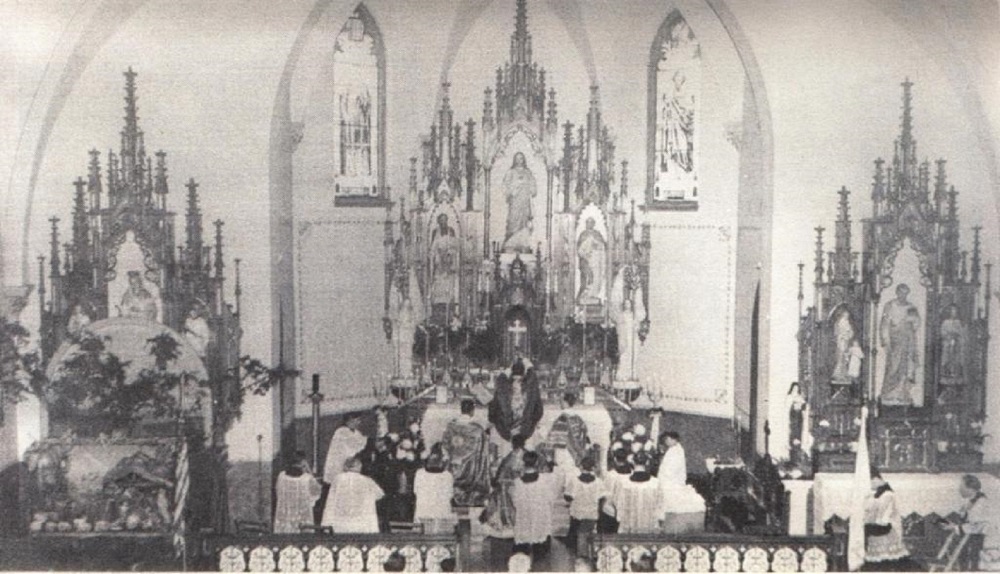
In 1948, the parish was one of fourteen in the Ottumwa Deanery that formed the Notre Dame Catholic Youth Organization. It provided social and other contacts for youth in the area.
In June 1950, lightning struck the church's bell tower and set it on fire. The next evening, Martha and Celeste Weber were practicing the organ in the choir loft. Hearing a rumbling noise in the tower, they thought some boys were trying to frighten them. They left their music on the organ and ran home to tell their father. He returned with them and when he opened the door, flames came out. The noise heard by the girls had been caused by parts of the large beams, which had been burning since the night before, finally burning through and dropping to the floor. Fortunately, there was no serious structural damage.
Sometime in the early 1950s, a third south section was added to Sts. Peter & Paul Catholic Cemetery.
In 1953, the sanctuary chimes were donated in memory of Clarence P. Adrian, who was killed while helping a neighbor put in a basement foundation. The date on the chimes is March 19, 1953.
In the spring of 1955, Fr. Paul Kleinfelder, never sick in his life, came down with mumps. Complications set in when he also suffered a stroke, paralyzing his right side. Through one weird night with the rain pouring down outside, his parishioners maintained a vigil at his side. Through the succeeding weeks they ministered to him as he had ministered so long to them. A long convalescence followed. Staunch determination and will power brought some usefulness back to the withered limbs. Treatments at Sacred Heart sanitarium in Milwaukee, Wisconsin enabled him to return home, capable of offering Mass, which he resumed as soon as he was physically able.
.png)
In June 1955, the bishop had sent an assistant, Fr. William F. Wiebler, a newly ordained priest, to help the afflicted pastor. The arrangement was to prove a profitable one. The older priest gave the benefit of his wisdom and holiness to the younger, while the young Levite gave the use of his limbs and agility to the older priest so that parish work might go on.
In 1956, in preparation for the Centennial of Sts. Peter & Paul Catholic Parish, Fr. Paul Kleinfelder called a general parish meeting which resulted in the redoing of the interior and ultimately the exterior of the church. Twelve “apostles” were chosen from among former trustees to lead the campaign. In a whirlwind of activity, they raised $13,500.
Immediately after Easter 1956, the work of destruction began. No sooner had Mr. and Mrs. Don Paarman left the church in a shower of marital rice than the school children were stripping the altars of their linens and candelabra. Statues, altars, pews, stations and pre-dieus, the organ, vestments and other furnishings were removed from the church.
A temporary church was erected in the basement and was used for two months. Eighth grade graduation, First Holy Communion, and a funeral were held in the basement. Except for a few bumped heads the parishioners cheerfully put up with their catacomb church.
Upstairs the church was further stripped of its plaster and lath. The work had been scheduled to take two weeks, but the parishioners turned out in such force and worked with such diligence that the job was done in two days. They appeared with ladders, wrecking bars, trucks and hammers and returned home laden with plaster dust, having put in a good day’s work. The church was now stripped of everything and only its bare walls remained.
Then they began the slow task of rebuilding. Preliminary work was begun by the Roe Roofing Company of Washington, Iowa. Roofs were made tight and weatherproof. Copper flashing was renewed between the tower and church and around the two chimneys. Sacristy roofs were caulked, reflashed, and retarred. A new cross was specially made in the shop and erected to replace that which had been demolished by the storms. Outside the church, the old stone steps in front of the church were replaced with concrete steps and new cement walks were built.
Interior work began with metal lathing. Parishioners again helped with this work. The entire church skeleton was covered with metal lath. The fireproof material replaced the old wood lath and gave a smoother base for the new plaster.
Orville Thompson of Sigourney, Iowa, had the plastering and lathing contract. The project called for tons of sand and plaster to be applied to the walls and ceiling of the building and it was done in three weeks. The tremendous height of the ceiling (35 feet to the interior beams) necessitated a steel scaffold from Cedar Rapids which covered the entire church and provided easy access to the high arches on the ceiling. On the scaffold, the plasterers applied scratch coats, browning coats and finishing coats of plaster until the church began to look clothed once again. Acoustic plaster was used on the ceiling, with the final coat sprayed on to give a rough textured finish. Use of the acoustic plaster improved the acoustics of the church so much that a whisper in the sanctuary can now be clearly heard in the choir loft.
Wooden windowsills were replaced with cement and sloped at a slight angle. Ornamental plaster column heads were replaced with simplified continuations of the arches into the walls. The tinted plaster was given a sand finish to contract with the acoustic ceiling. A color scheme using grays, greens and browns as worked out for the church. To complement the Creole gray of the ceiling the walls were tinted Seafoam Green. To contrast with the nave of the church the sanctuary and tower walls were tinted Autumn Buff.
Flave Hagist of the Keota Electric Company rewired the entire church and installed the new incandescent lighting system. Two spotlights were centered on the altar to provide the celebrant with adequate lighting where needed for the missal used at the Mass. Two floodlights were mounted on the ceiling arches to light up the entire sanctuary. Six Gothic-style lanterns with louvers were hung in the nave of the church. Six spotlights were recessed in the choir’s balcony quarters and four recessed fixtures under the balcony were provided to light the rear pews. Outside porch lights with switches at the convent and rectory were fixed above the sacristy entrances. A reading lamp for the priest to say his office in the presence of the Blessed Sacrament was affixed to the sanctuary wall.
Ed Rains of the Rains Furniture store of Keota supervised the laying of the Masonite under-flooring and rubber tile which covers the nave of the church and the vestibule. Large 12x12 blocks of ecrulite color were accentuated with two parallel stripes of mottled red running down the center aisle and the red baseboard around the outside wall. In the sacristies, linotile of soft gray and rose was laid. Stair treads were placed on the choir loft stairs.
Parishioners refinished the sanctuary floor and predellas. The oak and maple floors were sanded, sealed and given a natural light finish. Blue carpet runners were laid on the main predella. Varnish was removed from all woodwork in the church which was revarnished as were the vestment case and communion table.
Miss Genevieve Schmidt of Fort Madison, Iowa, lived in the rectory for several months while she was refinishing the statues in her school-loft studio. Statues of the Sacred Heart, St. Peter, St. Paul, the Blessed Virgin and Child, St. Joseph, St. Henry, St. Anne, St. Mary Magdalene and St. Aloysius were redone. The Little Flower statue was put in a special niche in the priest’s sacristy. St. John the Baptist remained in his traditional place above the baptismal fount. The old mission cross from 1913, previously hanging on the side wall, was repainted and hung in a prominent position on the tower wall in the choir loft. Browns, reds, greens, cream and blues were used on the statues. St. Peter and St. Paul were garbed in the colors of the church, tan and green, to signify their patronage of the edifice. Missing fingers, broken through the years, or lost symbols, were replaced. The statue of St. Joseph was restored a lily and King Henry regained his scepter.
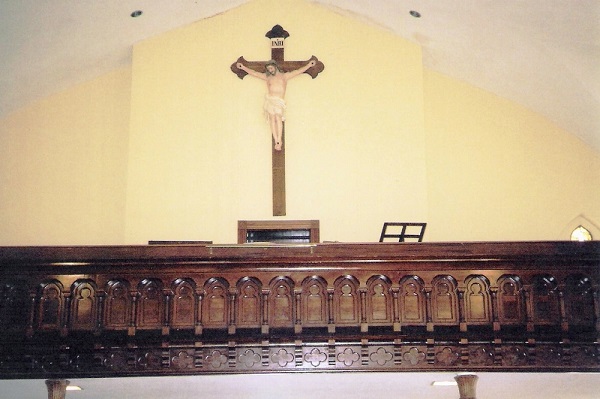
The large and bulky vestment case in the priest’s sacristy was dismantled and rearranged. Relocation of the upper portion of the vestment case made it more accessible for storage of linens and Mass articles. The lower portion of the vestment case thus gained more room for the laying out of vestments.
A 96-year old corpus of the crucified Christ was found in the tower loft. The corpus was hand-carved by one of the pioneer founders of the parish and was part of the original altar in the first church. The corpus was stripped of its paint and refinished. It was hung above the vestment case in the sacristy. Fr. Joseph Rangger’s picture, in an ornate brass frame, was rehung on the wall of the church he built so many years before.
Carpentry work was done by Bill Yoder of Keota. New windows were put in the sacristies, the pews renovated, timbers replaced in the tower, a closet built in the server’s sacristy, communion rail remodeled and general repair work.
In order to make the communion rail more accessible and to enlarge the sanctuary the table was moved from the sanctuary to the floor of the church and mounted on a platform directly in front of the pews. Its previous location at the top of the three steps caused difficulty for the older people in receiving communion. The ornate rail was lowered to the floor, made into a prie-dieu, and simplified. The platform was padded with white leatherette and a bronze chain hung between the two portions of the rail.
On Wednesday, August 1, 1956, the Feast of St. Peter-in-Chains, Sts. Peter & Paul Catholic Church at Clear Creek was rededicated under its dual patrons in recognition of the renovation program that was recently completed, and in honor of Fr. Paul A. Kleinfelder, who completed his 26th year in the parish on July 1, 1956. The Most Rev. Ralph L. Hayes, Bishop of Davenport, preached the sermon at the solemn High Mass which was celebrated by Fr. Michael Diedrich, S.C.J., at 10:00 a.m. Other celebrants of the Mass were Fr. James Grubb of St. James Parish in Washington, Iowa; Fr. L. Jerome Leinen of St. Paul’s Parish in Burlington, Iowa; Fr. Francis Hendricksen of St. Mary’s Parish in Fairfield, Iowa; Fr. Martin J. Diamond of St. Elizabeth’s Parish in Harper, Iowa; and Fr. James Mackin of St. Mary’s Parish in Sigourney, Iowa. Members of the Knights of Columbus, Fourth Degree, formed an honor guard.
A picnic dinner was held on the parish grounds immediately after the Mass. The picnic dinner was open to all those who attended Mass, including parishioners, former parishioners and friends. Each family brought a meat dish and another side dish as well as their own tableware. Coffee and lemonade were provided. The Catholic Youth Organization sponsored a pop and ice cream stand on the ground and the Altar and Rosary society sold pies and coffee in the afternoon. There was an open house in the afternoon. Members of the surrounding communities, both Catholic and non-Catholic, attended to view the building improvements. The Clear Creek C.Y.O. softball team played the Harper C.Y.O. at 1:30 p.m. on the Clear Creek diamond. Benediction of the Most Blessed Sacrament at 3:30 p.m. closed the day’s activities though the church remained open to visitors all evening.
The rededication of Sts. Peter & Paul Catholic Church served as a day of recognition by the parish for the 26 years that Fr. Paul Kleinfelder had spent at Clear Creek. Any celebrations the year before when the 25th year mark was reached were postponed because of the grave illness which afflicted him then. By this time, Fr. Paul Kleinfelder was able to offer Mass and to be up and around, for which his parishioners were grateful. As a token of their appreciation they presented him with a purse on the occasion.
To honor the eight children of Richard and Ruth Hammes who were killed in a car-train accident on October 25, 1956, the Richard Hammes Family Memorial was erected in Sts. Peter & Paul Catholic Cemetery at Clear Creek in 1957. It features St. John and the Blessed Virgin Mary standing at the foot of the cross, symbolizing the sorrow of the parents. At the redwood cross base are eight heads of wheat in memory of the eight children. The base was constructed of rocks from parishioners and the Hammes rock garden where the children played. The cornerstone of the old 1863 church building was used in this memorial and the plaque names the Hammes children who died in the accident.
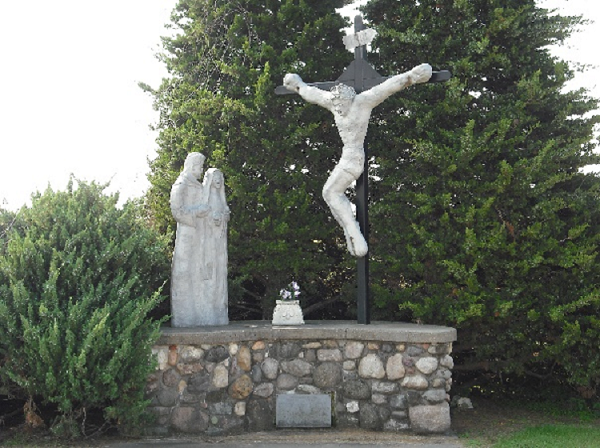
.png)
On June 7, 1957, Fr. Marvin Sieger arrived to replace Fr. William Wiebler as Assistant Pastor to Fr. Paul Kleinfelder at Sts. Peter & Paul Catholic Church at Clear Creek.
Some dispute arose over the date of 1858 as the basis for the true centennial year of the parish. Complete records are lacking. There are many beginnings of the parish: the purchasing of the log house, the offering of the first Mass, the selecting of the trustees, the securing of a transient pastor. Accordingly, Fr. Paul Kleinfelder was determined to select a date appearing to coincide with the many firsts in the parish. The final date for the celebration, August 19, 1958, was selected by the Most Rev. Ralph Hayes, Bishop of Davenport.
An estimated crowd of 5,000 people attended the day-long celebration of the parish centennial at Sts. Peter & Paul Catholic Church on Tuesday, August 19, 1958. About 2,500 people were on the grounds at one time during the evening. The celebration began in the morning when Bishop Hayes of Davenport celebrated the Mass of the Trinity at 10:00 a.m. Fr. William Wiebler, Assistant Pastor at Clear Creek during 1956, preached the centennial sermon to 800 people.
The Mass was followed by a chicken dinner in the church basement at 11:45 a.m. and the Sigourney Saddle club staged a horse show at 2:00 p.m. At 6:30 p.m., a post office auction was held. Auctioneers were Bill Brudy of Washington, E.E. Tremmel of Sigourney, Ed O’Brien of Kinross and Jake Hendrickson of Richland. 109 packages were mailed to the parish by former members, friends and well-known personalities. Donors included Mamie Eisenhower, Bishop Fulton J. Sheen, Governor Herschel Loveless, Senator Bourke Hickenlooper, Senator Thomas Martin and Secretary of Agriculture Ezra T. Benson. All packages were auctioned unopened.
Booths were open during the celebration. A platform dance was held at 9:00 p.m. and dance prizes were awarded to Mr. and Mrs. Peter Peiffer in the oldster’s group and to Terry and Kathy Horras, children of Mr. and Mrs. Albert Horras of Keota, in the teenage group.
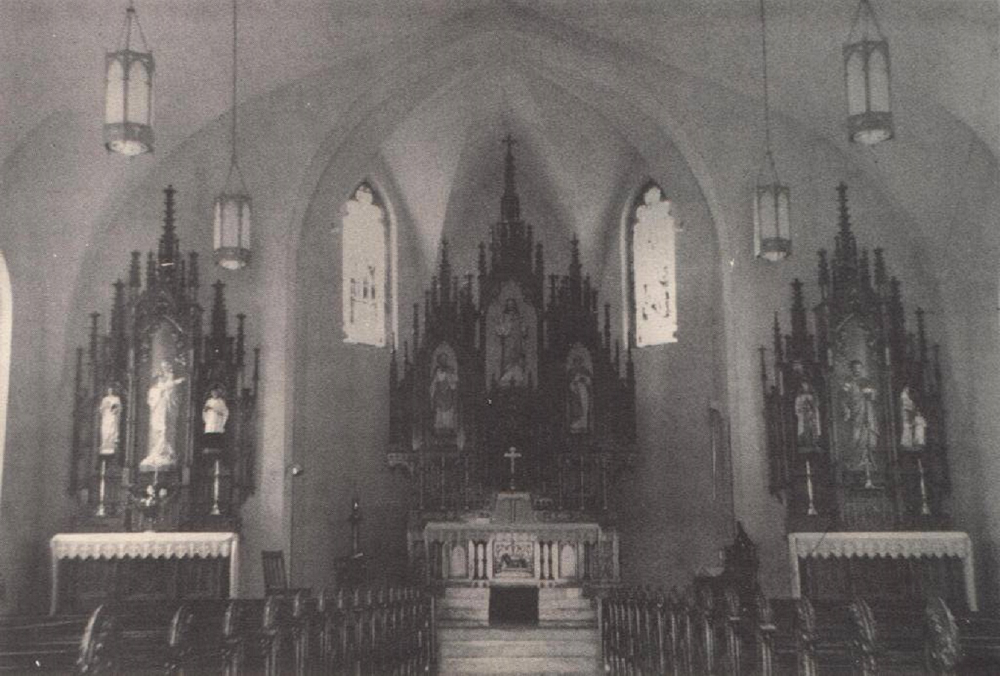

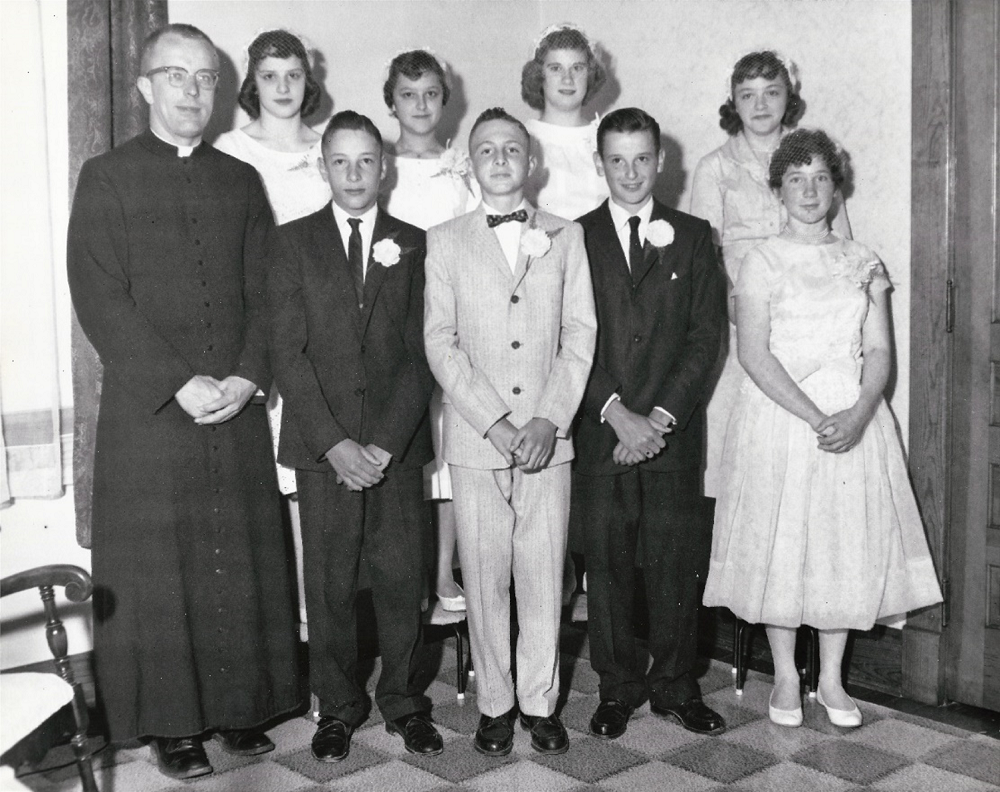
In December 1961, Fr. Paul Kleinfelder’s condition had grown worse and he was taken to a Burlington nursing home run by Sisters. Fr. Marvin Sieger was left in charge of the parish.
.png)
In July 1962, Fr. Francis Lollich arrived at Clear Creek with Mrs. Ruth Neashem, housekeeper and organist. At his sermon on July 4, 1962, Fr. Francis Lollich said that he was not there to raise chickens and grow a garden. He took sealed bids and sold off the chicken shed, pulled out the garden fence and landscaped the yards, and took bushes and shrubs out around the rectory and church.
Fr. Kleinfelder passed away on December 18, 1962. He chose to be laid to rest in Sts. Peter & Paul Catholic Cemetery at Clear Creek, where he spent over 30 years as pastor. Bishop Hayes and numerous priests and Sisters came for the funeral on Friday, December 21, 1962. Because it was Friday, there was no meat allowed for the funeral dinner. Facilities were small in the parish hall kitchen and they had to borrow an oven to bake the salmon loaf. That could well be the reason Fr. Francis Lollich decided to renovate the parish hall in 1963.
In the fall of 1963, renovations began in the basement at Sts. Peter & Paul Catholic Church at Clear Creek. Much of the basement where the current kitchen is located had to be dug out, supports were installed to support the weight of the tower, cement was poured, a new gas heating plant was installed in the old kitchen area, plumbing was installed for the kitchen and restrooms, the ceiling was installed, cupboards were built, and the walls were covered with panelling. On the west side, a small addition was built to provide direct outside access to the basement. The work continued during the winter months. The new spacious hall was completed in 1965 and dedicated at Fr. Francis Lollich’s 25th anniversary on May 4, 1965. The total cost for renovations was $21,156.48, including $10,759.67 for labor and materials and $10,396.81 for the new furnace, kitchen and hall equipment.
In 1965, a new altar, pulpit, lectern, and communion station were purchased by members of the parish. The temporary altar, on which Mass was offered for the first time on February 25, 1961, gave way to the beautiful wood pieces that matched.
In 1967, the stained-glass windows at Sts. Peter & Paul Catholic Church at Clear Creek were re-leaded and sealed with protective storm windows at a cost of $5,538.75.
In 1968, the Sts. Peter & Paul Catholic School at Clear Creek had 68 students in grades 1-8. That year, with the new law limiting two grades to a classroom and a shortage of teaching nuns, the Sts. Peter & Paul Catholic School at Clear Creek was closed.
In the spring of 1969, shortly before Fr. Francis Lollich left, he decorated the altars with gold leaf to enhance their natural beauty.
.png)
Fr. Francis Lollich was succeeded by Fr. John Hebenstreit in August 1969. Martha Kelly was Fr. Hebenstreit’s cook and housekeeper. Fr. John Hebenstreit loved the rural area. Soon the yard and cemetery took on a neat appearance.
Fr. John Hebenstreit also established the parish council. He knew that the parish belonged to the people and that the priest was called to work closely with the Council in serving the parish. These were not easy times. Parish Councils were beginning to make decisions, and it’s a real challenge to learn such a new responsibility quickly. And those changes to a parish that was accustomed to getting things done, and a church that was renewing, and God only knows what can happen.
In 1970, Sts. Peter & Paul Catholic Church needed to be painted as the new tinted plaster that had been done in 1956 began to fade. A meeting was called to get bids on the job and they met with a decorator who was doing a neighboring church. He suggested taking out the altars and replacing the old organ with a pipe organ. The steam was rolling high that night. No one was going to let those beautiful hand-carved altars go out the door.
Bids were again taken to paint Sts. Peter & Paul Catholic Church the church in February 1971. Norbert Peiffer and crew redecorated it in March 1971 and the church was all cleaned and finished in time for Easter that year on April 10, 1971.
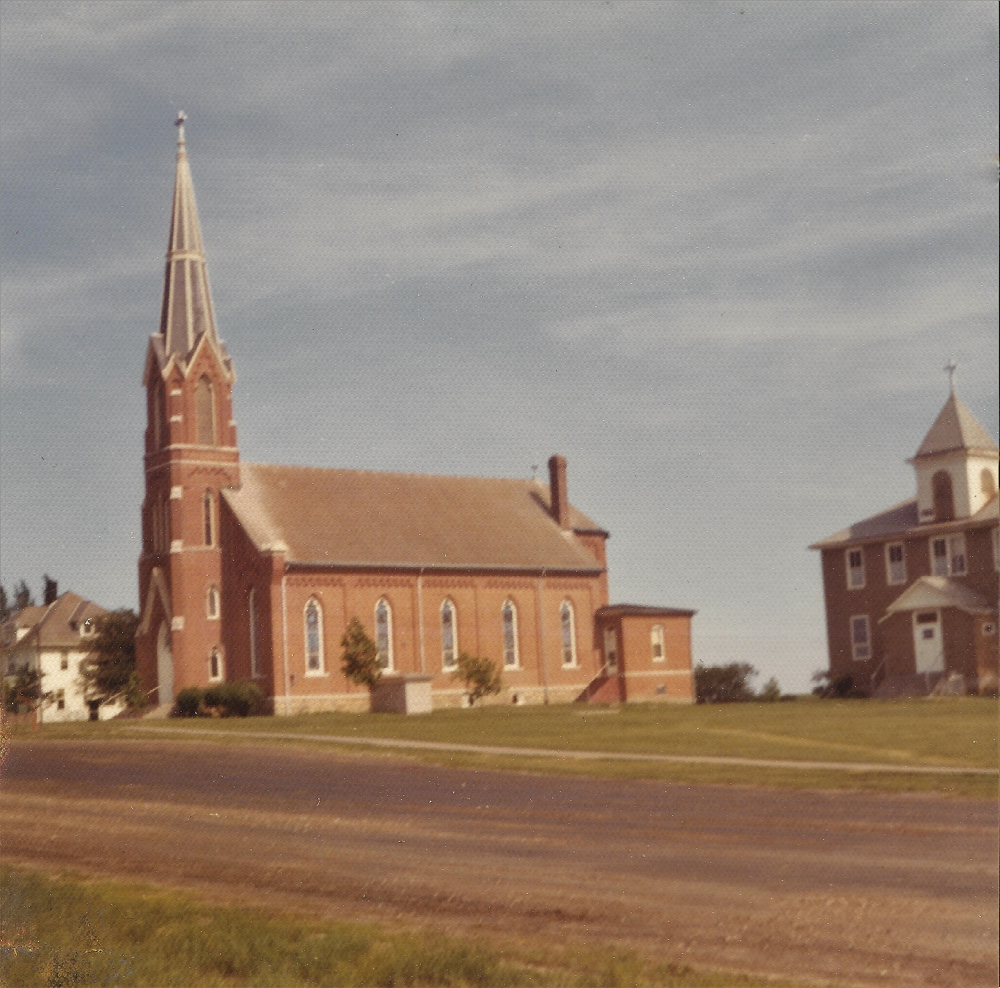
In 1977, Clear Creek voted to become a member parish of the Harper-Keota Catholic School system. From very early on its beginnings, the school was part of the parish, and thanks to Fr. John Hebenstreit’s love of children, it returned.
Times were not easy for Fr. John Hebenstreit, for it seems that sickness has no respect for anyone. Father’s sickness impaired the very pastoral work that he did best, which was being one with his people and communicating with them in speech and leadership. In those days it became increasingly difficult for him to communicate plainly in his speech, but not even that could block the communication of love for his people. The good memories of his snowmobile and motorcycle are only tainted by the pain of a broken ankle. But always, Fr. John Hebenstreit yearned for the friendships and support of the people, whether it be an afternoon of hunting, a round of golf, a late night visit to a home, or a pastoral call to the sick. A good pastor loves being with his people and that was Fr. John Hebenstreit.
.png)
In 1979, it became necessary for Fr. Hebenstreit to retire due to his sickness, although he would continue to live in the rectory for a time. Changes are not always easy, and so the parish was challenged in an entirely new way in February 1979. Fr. Bob McAleer, who was already serving St. Elizabeth Catholic Church at Harper, was appointed by the Most Rev. Gerald O’Keefe, Bishop of Davenport, to share his time between the two parishes. After so many years history repeats. Again, the parishes would share a priest, and Clear Creek would no longer have a resident pastor.
It was not easy for many to understand and to accept the new arrangement. The plea “we want our own priest” was hardly in line with the church and the availability of priests that could serve parishes. The hard realization for the necessity to change only becomes more apparent as the years go by. And so those beginning days weren’t easy.
Fr. Bob McAleer from the very beginning approached the parish honestly, directly, and candidly. He sensed a rift in the spirit of the parish. Fondly, he remembers those first two Sundays. As he read the bishop’s letter to the parish directing the parish to cooperate, support the school, and combine C.C.D. programs, he hoped all would join in. The bishop’s words, “Do this and you will live,” are proved today in our “alive parish.” And sometimes Fr. Bob McAleer says his knees still shake when he recalls his second Sunday when he came down the center aisle before Mass and from his heart told the parish “that scripture says we are to make peace with one another." We were never taught to speak in church but he told us it was far more important to talk with one another.
Fr. John Hebenstreit continued to live in the rectory at Clear Creek. On June 28, 1979, the parish gathered for a farewell party honoring Fr. John Hebenstreit, who had been their pastor for 10 years. Many of the parish helped Fr. John Hebenstreit and Martha move on July 5, 1979, to Weller, Iowa, where he retired.
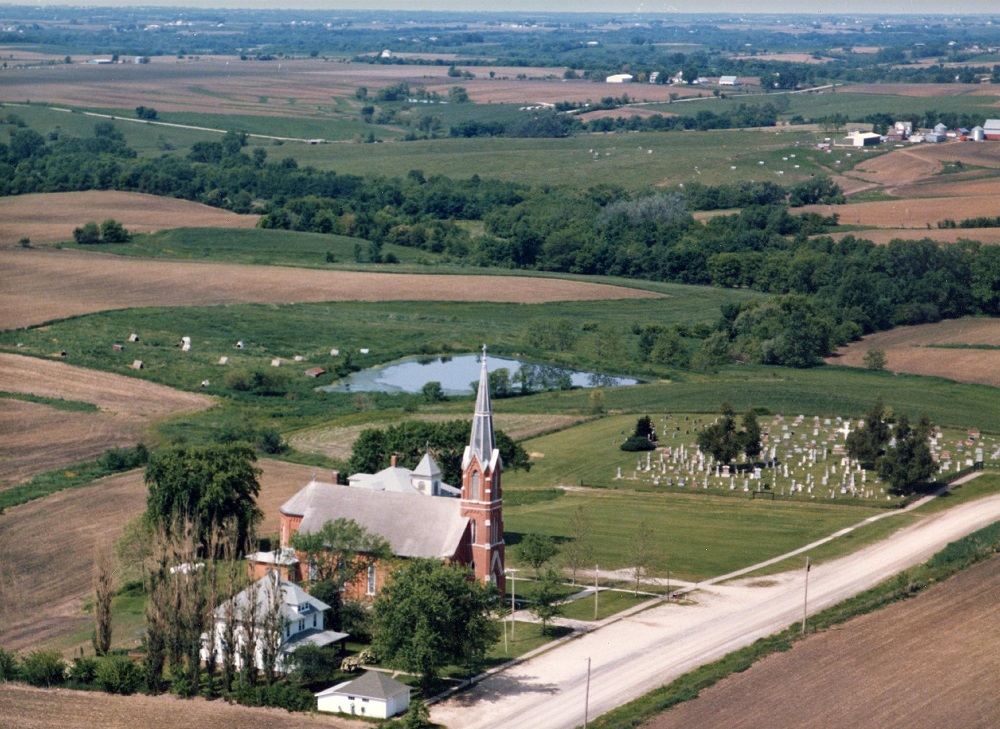
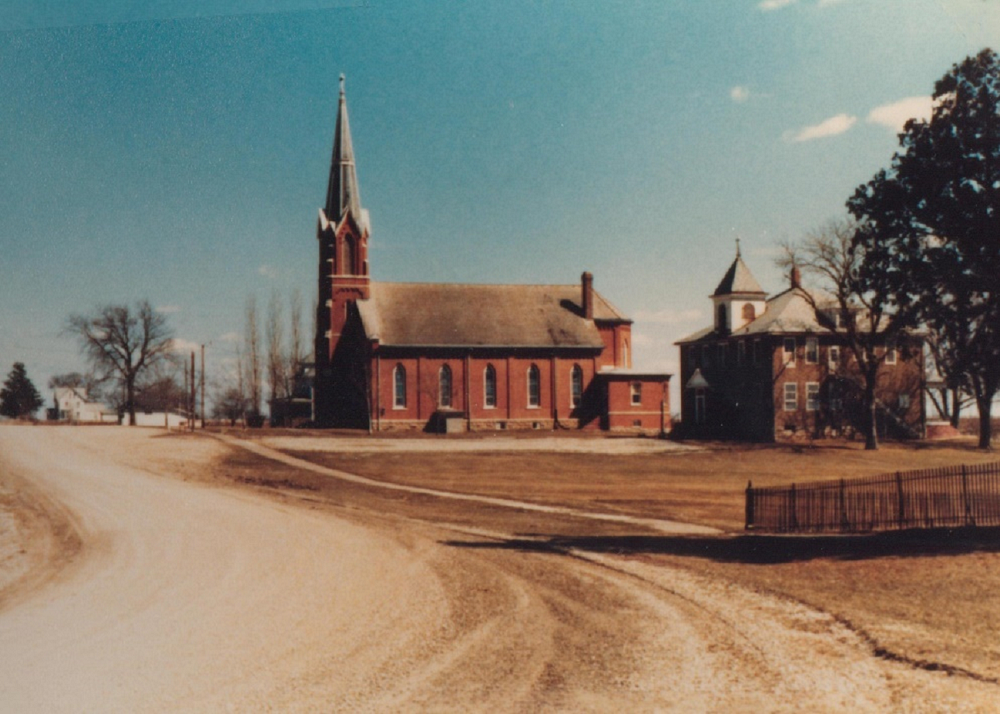
On June 25, 1983, Sts. Peter & Paul Catholic Church celebrated the parish’s 125th anniversary. The old school building was torn down in the fall of 1983.
In September 1984, Fr. Bob McAleer moved to St. Mary’s Catholic Church in Fort Madison, Iowa.
.png)
Fr.Bob Harness was appointed to serve both Sts. Peter & Paul Catholic Church at Clear Creek and St. Elizabeth Catholic Church at Harper, Iowa. In August 1988, Fr. Bob Harness also became pastor of St. Mary’s Catholic Church in Keota, Iowa.
In 1991, a brick monument was designed and built in front of Sts. Peter & Paul Catholic Church at Clear Creek by parish member Jeff Hammes. The money was raised by selling $1.00 chances on four quilts cut and sewn by Mrs. Ed (Virginia Greiner) Weber and Mrs. Alva (Isabelle Hammes) Baker, and hand quilted by parish ladies. The quilts were raffled off at the Pork Chop Supper the fourth Sunday of June that year. The cornerstone for the monument was laid on June 13, 1991. Inside this monument is the 1906 cornerstone from the second school.
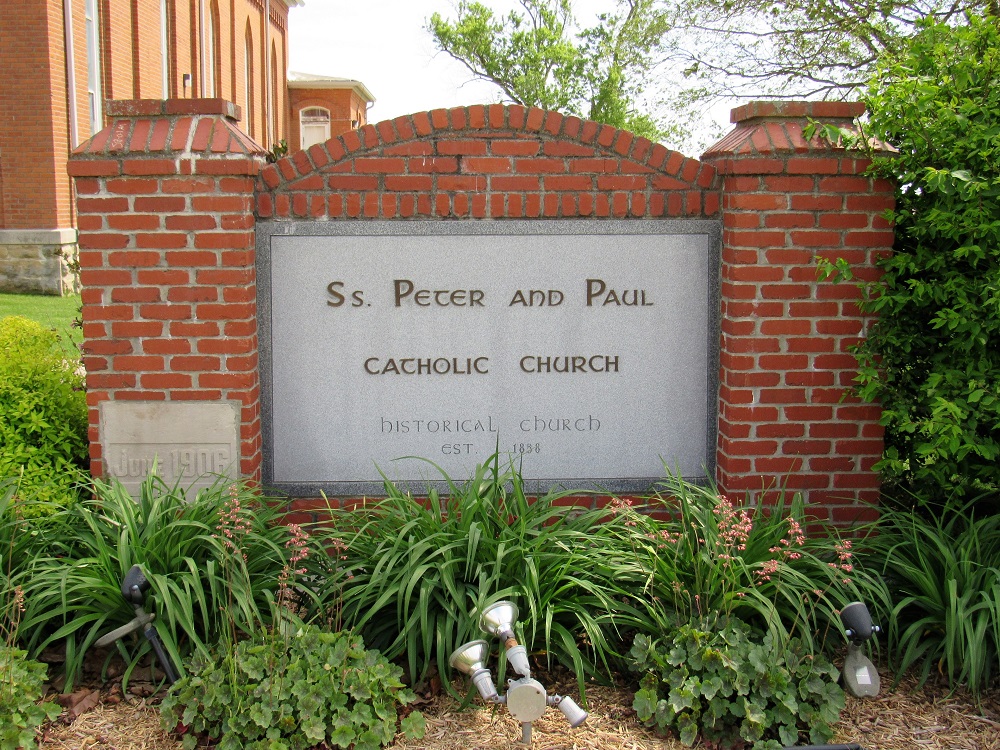

On July 1, 1992, Sts. Peter & Paul Catholic Church at Clear Creek, St. Elizabeth Catholic Church at Harper, and St. Mary Catholic Church at Keota officially consolidated into one parish. The congregation voted on what the new parish should be called and the decision was made to take the name Holy Trinity Parish.
On July 1, 1994, Fr. Bob Harness was transferred to St. Joseph’s Catholic Church in Dewitt, Iowa.
.png)
Beginning July 1, 1994, Fr. Tim Regan was appointed pastor of Holy Trinity Parish and churches in Clear Creek, Harper, and Keota.
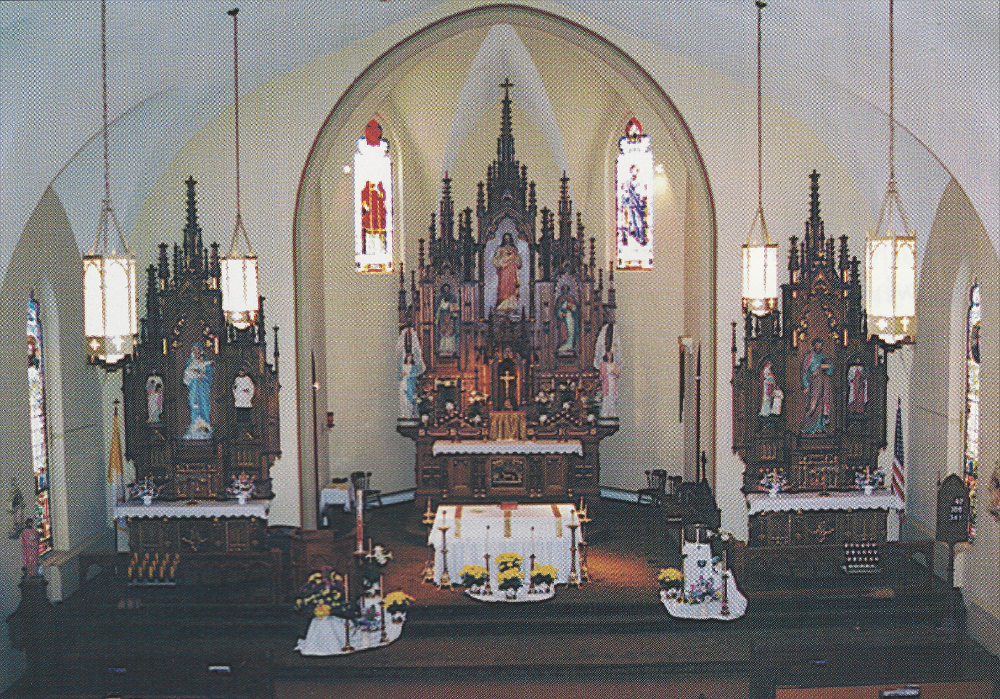
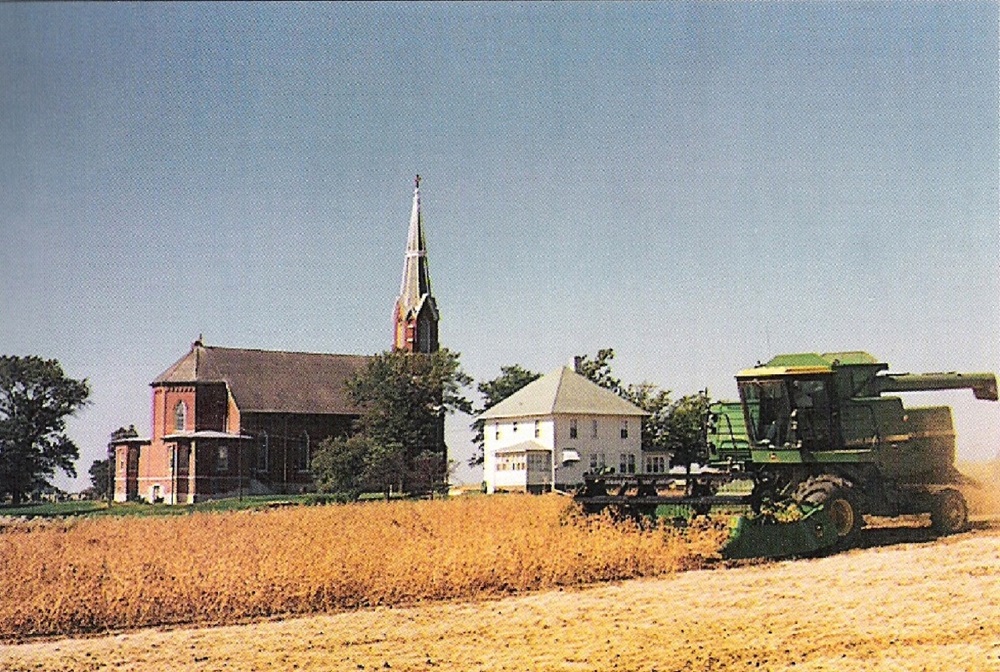
A crucifixion sculpture erected in 1911 at Sts. Peter & Paul Catholic Cemetery at Clear Creek was destroyed by lightning. On Saturday, June 21, 1997, a new Jesus on the Cross, sculpted by Paul Algueseva of Washington, Iowa, was dedicated.

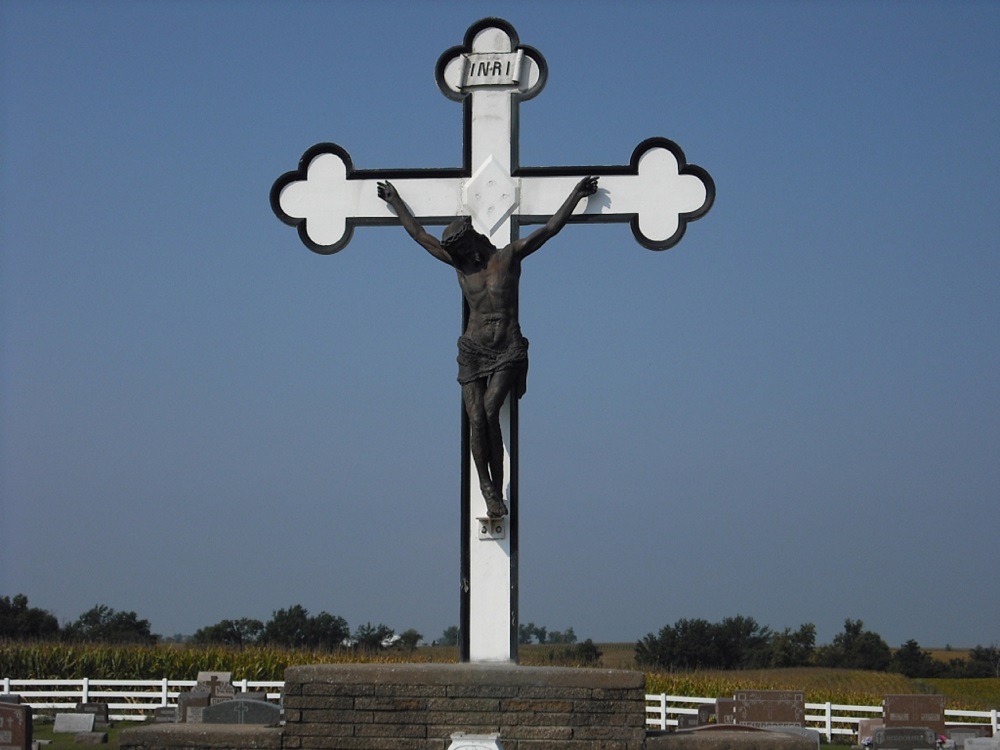

On Sunday, June 21, 1998, an 11:00 a.m. Mass and celebration commemorating the 100th anniversary of the laying of the cornerstone for the present Sts. Peter & Paul Catholic Church was held at Clear Creek with the Most Rev. William Franklin, Bishop of Davenport, and other special guests. An afternoon celebration included historic tours, a raffle of a beautiful handmade quilt and other items, bingo, children’s games, and a free meal.
.png)
On July 1, 1994, Fr. Tim Regan departed as pastor of Holy Trinity Parish and Fr. Marty Goetz became the new pastor.

The last regularly scheduled Sunday Mass at Holy Trinity Parish-Sts. Peter & Paul Catholic Church at Clear Creek was at 9:30 a.m. on Sunday, June 25, 2006, with pastor Fr. Marty Goetz officiating.
This is because six days later on July 1, 2006, Fr. Marty Goetz would also become pastor of St. Mary Parish in Sigourney, Iowa and Our Lady of Lourdes Parish in Keswick, Iowa. It was thought that maintaining a Mass schedule at five churches would be too much, so Masses were only scheduled at Holy Trinity Parish-St. Mary’s Catholic Church in Keota and St. Mary Parish in Sigourney.
Catholic weddings and funerals continued to be held at Sts. Peter & Paul Catholic Church at Clear Creek.
On July 1, 2007, Fr. Marty Goetz also became part-time Vocations Director for the Diocese of Davenport.
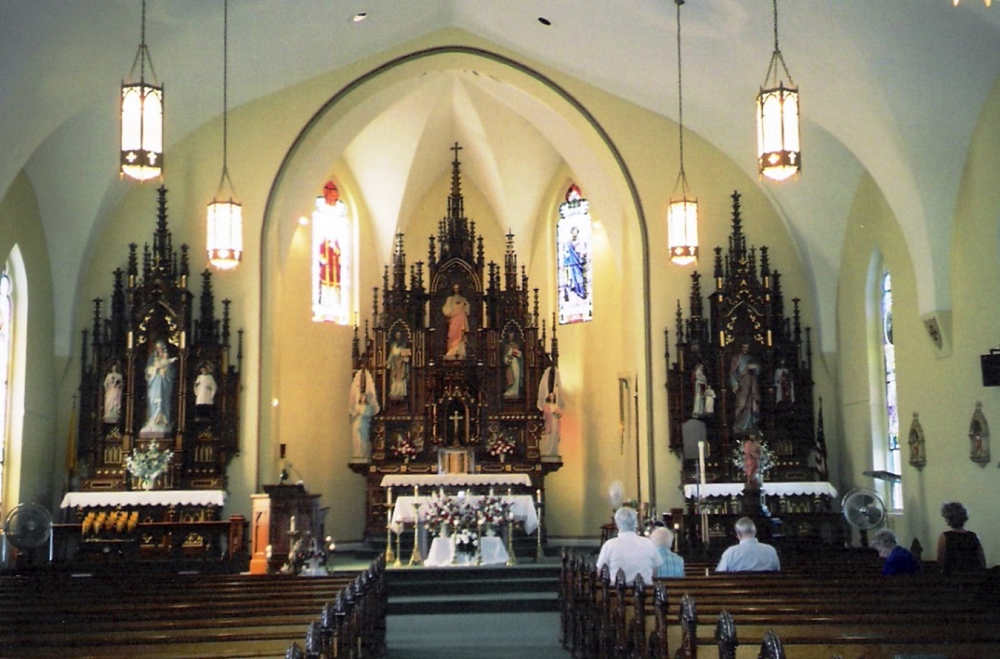
.png)
On February 1, 2008, Fr. Marty Goetz was reassigned to serve as full-time Vocations Director for the Diocese of Davenport. The Most Rev. Martin Amos, Bishop of Davenport, appointed Fr. Charles Fladung to serve as pastor of Holy Trinity Parish in Keota, Iowa, which also had jurisdiction over Clear Creek and Harper, and St. Mary's Parish in Sigourney, Iowa.
On Sunday, June 29, 2008, the Solemnity of Saints Peter & Paul, a Mass was held at Sts. Peter & Paul Catholic Church at Clear Creek to celebrate the 150th anniversary of the founding of the parish. Fr. Charles Fladung was exubert at the anniversary Mass and said, "My heart is full of joy to see a church full of people." His homily focused on Peter & Paul themselves, but he also touched upon the parish that took their names. After Communion, Mick Berg shared inspiring and sometimes humerous tales from the Clear Creek: A Torrent of Grace book written for the parish centennial in 1958.
On June 13, 2009, the Most Rev. Martin Amos, Bishop of Davenport, approved a motion by the Holy Trinity Parish Council to sell the building site at Clear Creek to the Heritage Association. On July 1, 2009, the real estate, including the Sts. Peter & Paul Church building and some ground around it, was transferred from Holy Trinity Parish to the Saints Peter & Paul Clear Creek Heritage Association for the consideration of $1.00.
In July 2009, the following photos of the bell tower and steeple bells were provided by Kade Hammes.


The top bell is engraved with 1866. This is because the top bell was installed in the previous church in 1866 and moved over when the present church was built. The two lower bells were installed in the present church in 1911.
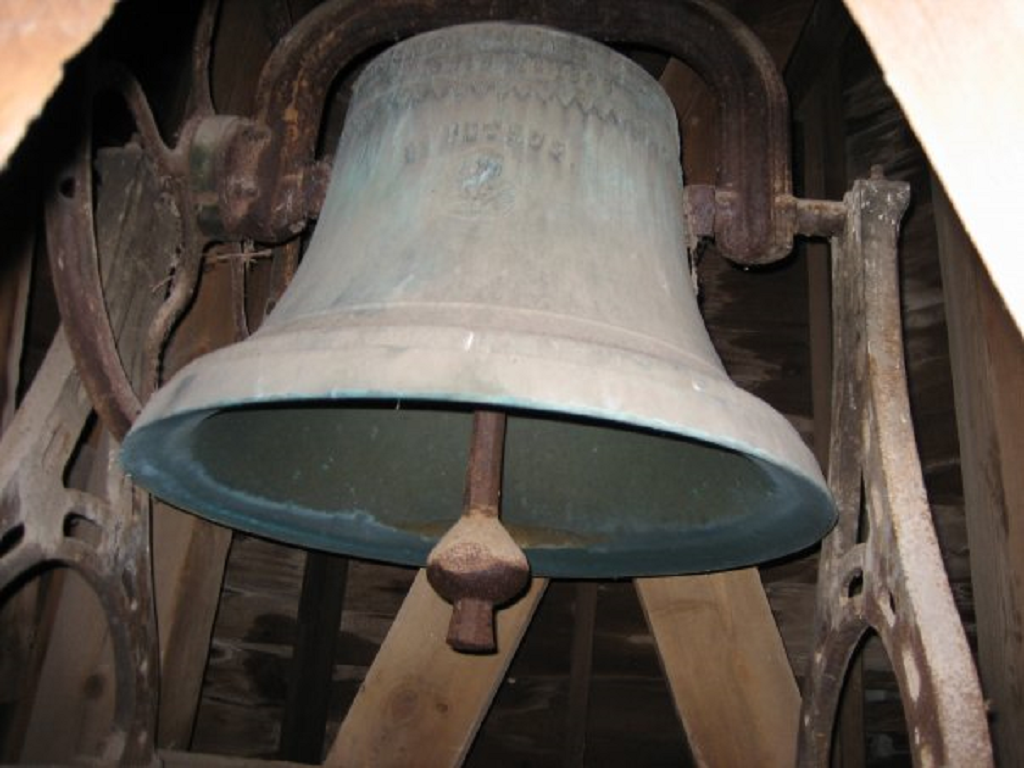

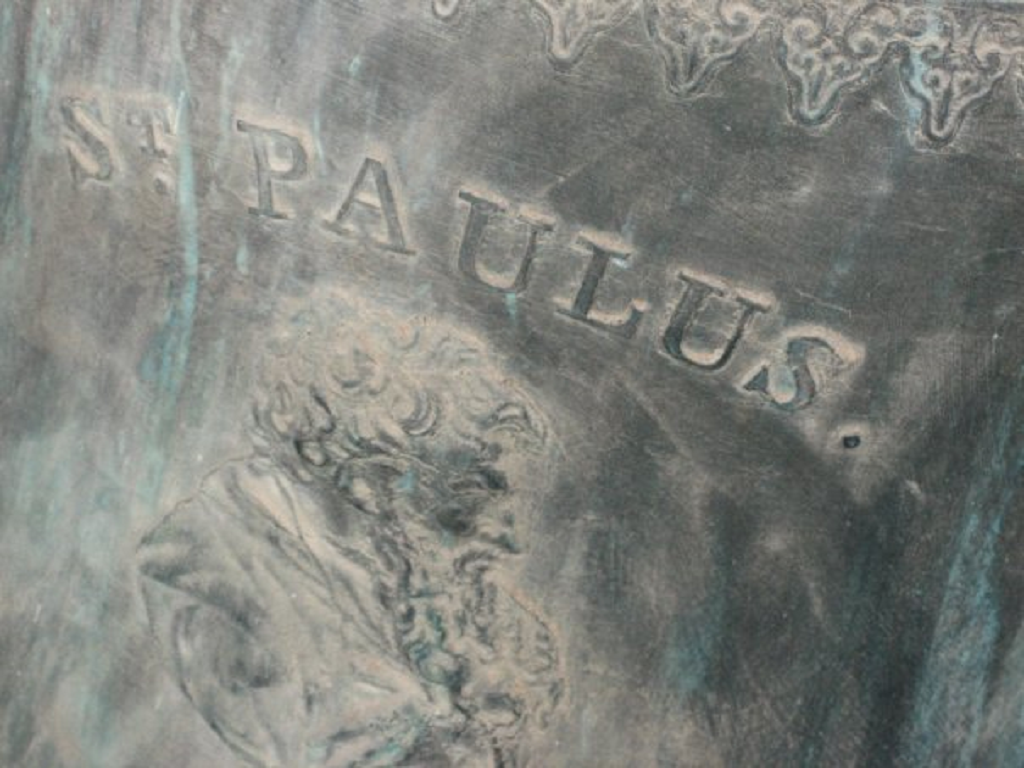
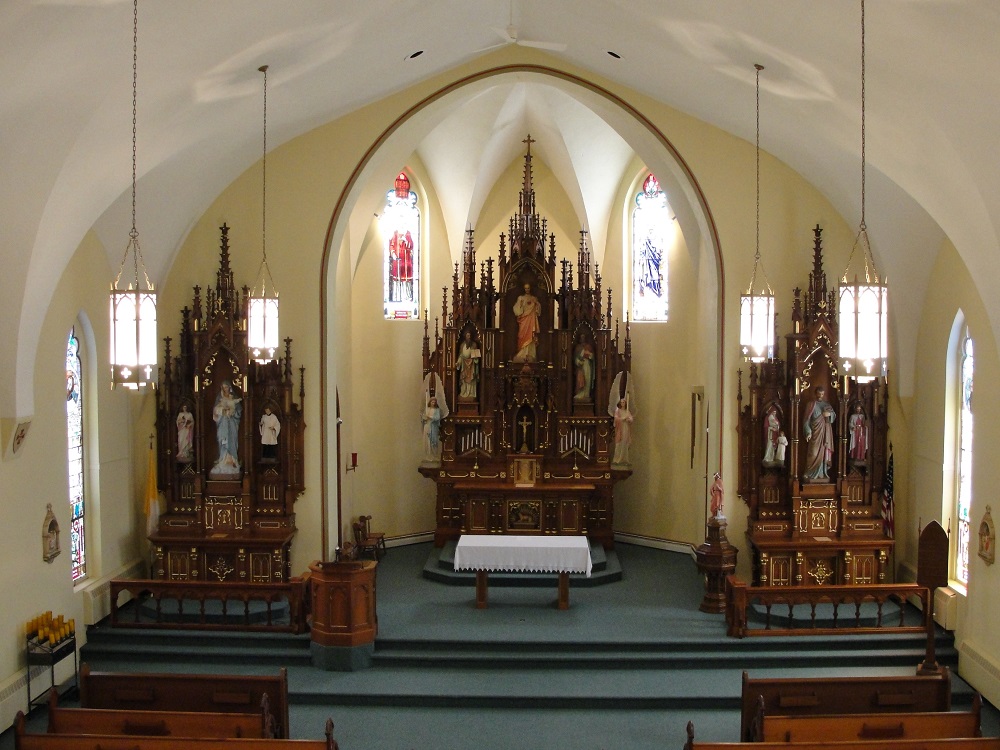
In 2011, work was done to restore the steeple and replace the roof.

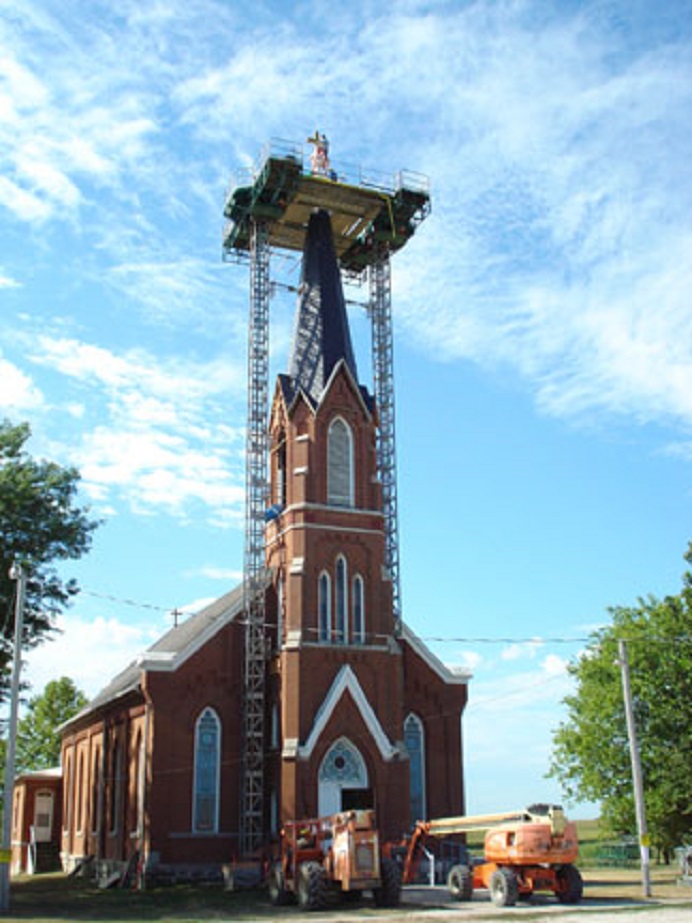
In 2012, the Saints Peter & Paul Clear Creek Heritage Association purchased an industrial refrigerator for the basement as well as new tables and chairs. Renovations were done to make the basement handicap accessible. The restooms were also renovated.
On June 30, 2016, the Saints Peter & Paul Clear Creek Heritage Association also purchased the rectory, which the parish had sold in 2003, from a Sheriff's sale.
In 2017, a new project began to restore the 22 stained glass windows. This was funded in part by a Washington County Riverboat Foundation grant of $30,000. The windows were removed and taken to Bovard Studios in Fairfield, Iowa, where they were restored and then brought back and reinstalled.
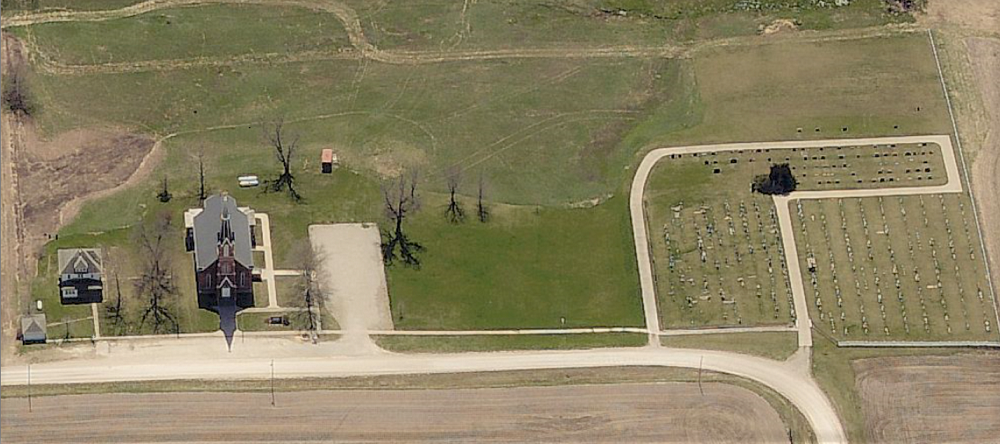
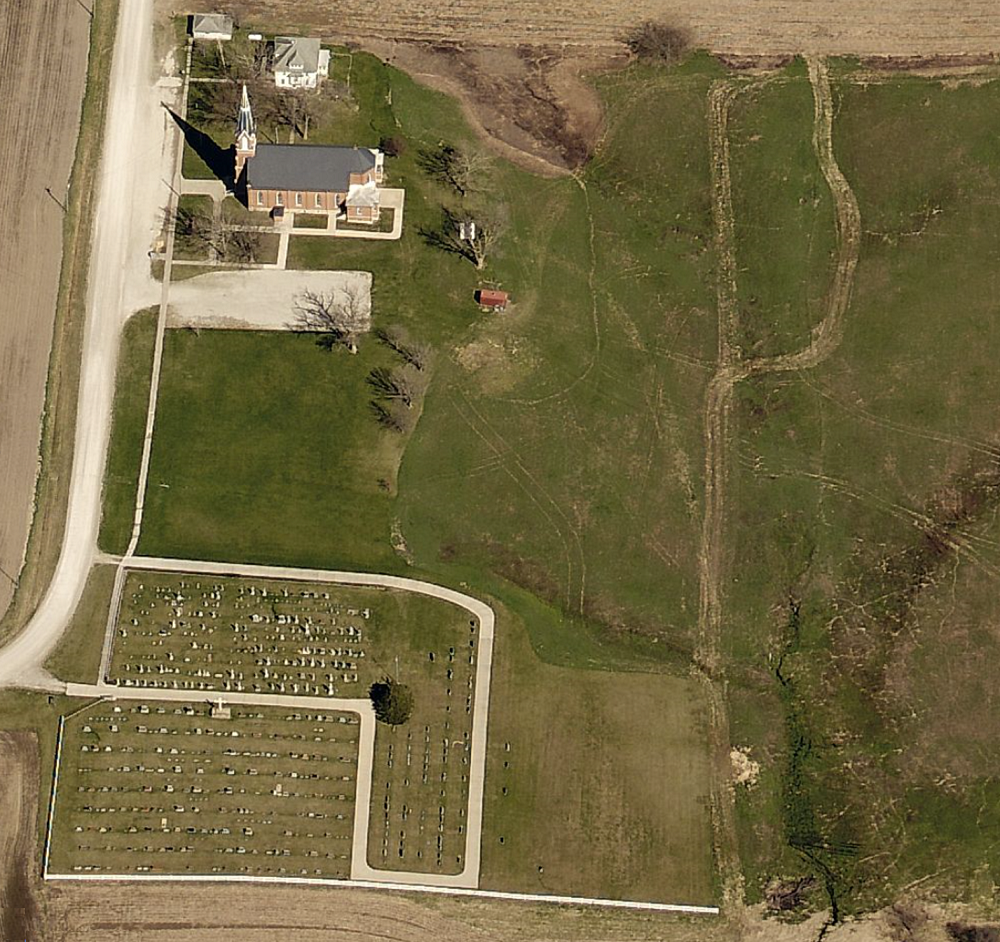

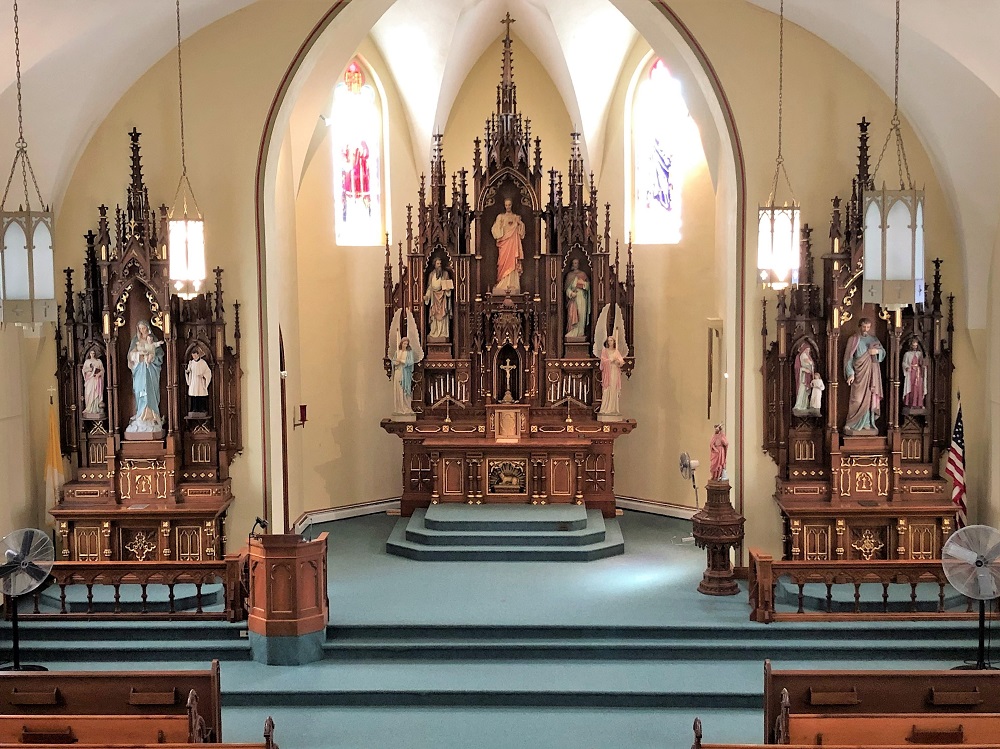
Resources:
The Catholic Messenger archives.
Pieffer, Rev. N.J. (1935). History of Sts. Peter & Paul Catholic Church of Clear Creek Township, Keokuk County, Iowa.
Wiebler, Rev. W.F. (1958). Clear Creek: A Torrent of Grace; A Centennial Historical Sketch of Sts. Peter & Paul Parish, Clear Creek, Iowa.
1983 Sts. Peter & Paul Parish Directory.
Page, W.C. (1985). National Register of Historic Places Nomination for the Sts. Peter & Paul Roman Catholic Church, Clear Creek Township, Keokuk County, Iowa.
1992 Holy Trinity Parish Directory.
1997 Holy Trinity Parish Directory.
2002 Holy Trinity Parish Directory.
2010 Holy Trinity Parish Directory.